Artificial Metalloenzymes: From Selective Chemical Transformations to Biochemical Applications
Abstract
1. Introduction
2. Recent Progress on the Various Reactions Catalyzed by ArMs
2.1. Reduction
2.1.1. Transfer Hydrogenation
2.1.2. Hydrogenation
2.2. Oxidation
2.3. C–C Bond Formation
2.3.1. Cyclopropanation
2.3.2. Friedel–Crafts Reaction
2.3.3. Michael Addition Reaction
2.3.4. Diels–Alder Reaction
2.3.5. Aldol Condensation
2.4. Unnatural Amino Acids
3. Cascade, Sequential, and Synergetic Reactions
4. Rapid Genetic Optimization and Directed Evolution of ArMs
5. Drug Applications
6. Conclusions and Perspectives
Author Contributions
Funding
Conflicts of Interest
References
- Turner, N.J.; Truppo, M.D. Biocatalysis enters a new era. Curr. Opin. Chem. Boil. 2013, 17, 212–214. [Google Scholar] [CrossRef] [PubMed]
- Bornscheuer, U.T.; Huisman, G.W.; Kazlauskas, R.J.; Lutz, S.; Moore, J.C.; Robins, K. Engineering the third wave of biocatalysis. Nature 2012, 485, 185–194. [Google Scholar] [CrossRef] [PubMed]
- Arnold, F.H. Directed Evolution: Bringing New Chemistry to Life. Angew. Chem. Int. Ed. 2018, 57, 4143–4148. [Google Scholar] [CrossRef]
- Brandenberg, O.F.; Fasan, R.; Arnold, F.H. Exploiting and engineering hemoproteins for abiological carbene and nitrene transfer reactions. Curr. Opin. Biotechnol. 2017, 47, 102–111. [Google Scholar] [CrossRef]
- Fasan, R.; Kan, S.B.J.; Zhao, H. A Continuing Career in Biocatalysis: Frances H. Arnold. ACS Catal. 2019, 9, 9775–9788. [Google Scholar] [CrossRef]
- Zhang, R.K.; Huang, X.; Arnold, F.H. Selective C H bond functionalization with engineered heme proteins: New tools to generate complexity. Curr. Opin. Chem. Biol. 2019, 49, 67–75. [Google Scholar] [CrossRef] [PubMed]
- Schwizer, F.; Okamoto, Y.; Heinisch, T.; Gu, Y.; Pellizzoni, M.M.; Lebrun, V.; Reuter, R.; Köhler, V.; Lewis, J.C.; Ward, T.R. Artificial Metalloenzymes: Reaction Scope and Optimization Strategies. Chem. Rev. 2018, 118, 142–231. [Google Scholar] [CrossRef]
- Jeschek, M.; Panke, S.; Ward, T.R. Artificial Metalloenzymes on the Verge of New-to-Nature Metabolism. Trends Biotechnol. 2018, 36, 60–72. [Google Scholar] [CrossRef]
- Vornholt, T.; Jeschek, M. The Quest for Xenobiotic Enzymes: From New Enzymes for Chemistry to a Novel Chemistry of Life. ChemBioChem 2020. [Google Scholar] [CrossRef]
- Davis, H.J.; Ward, T.R. Artificial Metalloenzymes: Challenges and Opportunities. ACS Central Sci. 2019, 5, 1120–1136. [Google Scholar] [CrossRef]
- Roelfes, G. LmrR: A Privileged Scaffold for Artificial Metalloenzymes. Acc. Chem. Res. 2019, 52, 545–556. [Google Scholar] [CrossRef] [PubMed]
- Oohora, K.; Onoda, A.; Hayashi, T. Hemoproteins Reconstituted with Artificial Metal Complexes as Biohybrid Catalysts. Acc. Chem. Res. 2019, 52, 945–954. [Google Scholar] [CrossRef] [PubMed]
- Churchfield, L.A.; Tezcan, F.A. Design and Construction of Functional Supramolecular Metalloprotein Assemblies. Acc. Chem. Res. 2019, 52, 345–355. [Google Scholar] [CrossRef] [PubMed]
- Koebke, K.J.; Pecoraro, V.L. Noncoded Amino Acids in de Novo Metalloprotein Design: Controlling Coordination Number and Catalysis. Acc. Chem. Res. 2019, 52, 1160–1167. [Google Scholar] [CrossRef]
- Lewis, J.C. Beyond the Second Coordination Sphere: Engineering Dirhodium Artificial Metalloenzymes To Enable Protein Control of Transition Metal Catalysis. Acc. Chem. Res. 2019, 52, 576–584. [Google Scholar] [CrossRef] [PubMed]
- Liang, A.D.; Serrano-Plana, J.; Peterson, R.L.; Ward, T.R. Artificial Metalloenzymes Based on the Biotin–Streptavidin Technology: Enzymatic Cascades and Directed Evolution. Acc. Chem. Res. 2019, 52, 585–595. [Google Scholar] [CrossRef]
- Lombardi, A.; Pirro, F.; Maglio, O.; Chino, M.; DeGrado, W.F. De Novo Design of Four-Helix Bundle Metalloproteins: One Scaffold, Diverse Reactivities. Acc. Chem. Res. 2019, 52, 1148–1159. [Google Scholar] [CrossRef]
- Mirts, E.N.; Bhagi-Damodaran, A.; Lu, Y. Understanding and Modulating Metalloenzymes with Unnatural Amino Acids, Non-Native Metal Ions, and Non-Native Metallocofactors. Acc. Chem. Res. 2019, 52, 935–944. [Google Scholar] [CrossRef]
- Natoli, S.N.; Hartwig, J.F. Noble−Metal Substitution in Hemoproteins: An Emerging Strategy for Abiological Catalysis. Acc. Chem. Res. 2019, 52, 326–335. [Google Scholar] [CrossRef]
- Reetz, M.T. Directed Evolution of Artificial Metalloenzymes: A Universal Means to Tune the Selectivity of Transition Metal Catalysts? Acc. Chem. Res. 2019, 52, 336–344. [Google Scholar] [CrossRef]
- Shoji, O.; Aiba, Y.; Watanabe, Y. Hoodwinking Cytochrome P450BM3 into Hydroxylating Non-Native Substrates by Exploiting Its Substrate Misrecognition. Acc. Chem. Res. 2019, 52, 925–934. [Google Scholar] [CrossRef] [PubMed]
- Yu, Y.; Liu, X.; Wang, J. Expansion of Redox Chemistry in Designer Metalloenzymes. Acc. Chem. Res. 2019, 52, 557–565. [Google Scholar] [CrossRef] [PubMed]
- Drienovská, I.; Roelfes, G. Expanding the enzyme universe with genetically encoded unnatural amino acids. Nat. Catal. 2020, 3, 193–202. [Google Scholar] [CrossRef]
- Köhler, V.; Wilson, Y.M.; Dürrenberger, M.; Ghislieri, D.; Churakova, E.; Quinto, T.; Knorr, L.; Häussinger, D.; Hollmann, F.; Turner, N.J.; et al. Synthetic cascades are enabled by combining biocatalysts with artificial metalloenzymes. Nat. Chem. 2013, 5, 93–99. [Google Scholar] [CrossRef]
- Hashiguchi, S.; Fujii, A.; Takehara, J.; Ikariya, T.; Noyori, R. Asymmetric Transfer Hydrogenation of Aromatic Ketones Catalyzed by Chiral Ruthenium(II) Complexes. J. Am. Chem. Soc. 1995, 117, 7562–7563. [Google Scholar] [CrossRef]
- Wang, D.; Astruc, D. The Golden Age of Transfer Hydrogenation. Chem. Rev. 2015, 115, 6621–6686. [Google Scholar] [CrossRef]
- Papini, C.; Sommer, C.; Pecqueur, L.; Pramanik, D.; Roy, S.; Reijerse, E.J.; Wittkamp, F.; Artero, V.; Lubitz, W.; Fontecave, M. Bioinspired Artificial [FeFe]-Hydrogenase with a Synthetic H-Cluster. ACS Catal. 2019, 9, 4495–4501. [Google Scholar] [CrossRef]
- Keller, S.G.; Probst, B.; Heinisch, T.; Alberto, R.; Ward, T.R. Photo-Driven Hydrogen Evolution by an Artificial Hydrogenase Utilizing the Biotin-Streptavidin Technology. Helv. Chim. Acta 2018, 101, e1800036. [Google Scholar] [CrossRef]
- Laureanti, J.A.; Buchko, G.W.; Katipamula, S.; Su, Q.; Linehan, J.C.; Zadvornyy, O.A.; Peters, J.W.; O’Hagan, M. Protein Scaffold Activates Catalytic CO2 Hydrogenation by a Rhodium Bis(diphosphine) Complex. ACS Catal. 2019, 9, 620–625. [Google Scholar] [CrossRef]
- Mirts, E.N.; Petrik, I.D.; Hosseinzadeh, P.; Nilges, M.J.; Lu, Y. A designed heme-[4Fe-4S] metalloenzyme catalyzes sulfite reduction like the native enzyme. Science 2018, 361, 1098–1101. [Google Scholar] [CrossRef]
- Cázares-Marinero, J.D.J.; Przybylski, C.; Salmain, M. Proteins as Macromolecular Ligands for Metal-Catalysed Asymmetric Transfer Hydrogenation of Ketones in Aqueous Medium. Eur. J. Inorg. Chem. 2018, 2018, 1383–1393. [Google Scholar] [CrossRef]
- Heinisch, T.; Ward, T.R. Artificial Metalloenzymes Based on the Biotin–Streptavidin Technology: Challenges and Opportunities. Acc. Chem. Res. 2016, 49, 1711–1721. [Google Scholar] [CrossRef] [PubMed]
- Quinto, T.; Schwizer, F.; Zimbron, J.M.; Morina, A.; Köhler, V.; Ward, T.R. Expanding the Chemical Diversity in Artificial Imine Reductases Based on the Biotin-Streptavidin Technology. ChemCatChem 2014, 6, 1010–1014. [Google Scholar] [CrossRef]
- Okamoto, Y.; Köhler, V.; Ward, T.R. An NAD(P)H-Dependent Artificial Transfer Hydrogenase for Multienzymatic Cascades. J. Am. Chem. Soc. 2016, 138, 5781–5784. [Google Scholar] [CrossRef]
- Facchetti, G.; Rimoldi, I. 8-Amino-5,6,7,8-tetrahydroquinoline in iridium(iii) biotinylated Cp* complex as artificial imine reductase. New J. Chem. 2018, 42, 18773–18776. [Google Scholar] [CrossRef]
- Hestericová, M.; Heinisch, T.; Lenz, M.; Ward, T.R. Ferritin encapsulation of artificial metalloenzymes: Engineering a tertiary coordination sphere for an artificial transfer hydrogenase. Dalton Trans. 2018, 47, 10837–10841. [Google Scholar] [CrossRef]
- Pellizzoni, M.M.; Schwizer, F.; Wood, C.W.; Sabatino, V.; Cotelle, Y.; Matile, S.; Woolfson, D.N.; Ward, T.R. Chimeric Streptavidins as Host Proteins for Artificial Metalloenzymes. ACS Catal. 2018, 8, 1476–1484. [Google Scholar] [CrossRef]
- Wu, S.; Zhou, Y.; Rebelein, J.G.; Kuhn, M.; Mallin, H.; Zhao, J.; Igareta, N.V.; Ward, T.R. Breaking Symmetry: Engineering Single-Chain Dimeric Streptavidin as Host for Artificial Metalloenzymes. J. Am. Chem. Soc. 2019, 141, 15869–15878. [Google Scholar] [CrossRef]
- Liu, Z.; Lebrun, V.; Kitanosono, T.; Mallin, H.; Köhler, V.; Häussinger, D.; Hilvert, D.; Kobayashi, S.; Ward, T.R. Upregulation of an Artificial Zymogen by Proteolysis. Angew. Chem. Int. Ed. 2016, 55, 11587–11590. [Google Scholar] [CrossRef]
- Okamoto, Y.; Ward, T.R. Cross-Regulation of an Artificial Metalloenzyme. Angew. Chem. Int. Ed. 2017, 56, 10156–10160. [Google Scholar] [CrossRef]
- Raines, D.J.; Clarke, J.E.; Blagova, E.V.; Dodson, E.J.; Wilson, K.S.; Duhme-Klair, A.-K. Redox-switchable siderophore anchor enables reversible artificial metalloenzyme assembly. Nat. Catal. 2018, 1, 680–688. [Google Scholar] [CrossRef]
- Pan, H.-J.; Huang, G.; Wodrich, M.D.; Tirani, F.F.; Ataka, K.; Shima, S.; Hu, X. A catalytically active [Mn]-hydrogenase incorporating a non-native metal cofactor. Nat. Chem. 2019, 11, 669–675. [Google Scholar] [CrossRef] [PubMed]
- Shima, S.; Chen, D.; Xu, T.; Wodrich, M.D.; Fujishiro, T.; Schultz, K.M.; Kahnt, J.; Ataka, K.; Hu, X. Reconstitution of [Fe]-hydrogenase using model complexes. Nat. Chem. 2015, 7, 995–1002. [Google Scholar] [CrossRef] [PubMed]
- Kokubo, T.; Sugimoto, T.; Uchida, T.; Tanimoto, S.; Okano, M. The bovine serum albumin–2-phenylpropane-1,2-diolatodioxo-somium(VI) complex as an enantioselective catalyst for cis-hydroxylation of alkenes. J. Chem. Soc. Chem. Commun. 1983, 769–770. [Google Scholar] [CrossRef]
- Köhler, V.; Mao, J.; Heinisch, T.; Pordea, A.; Sardo, A.; Wilson, Y.M.; Knörr, L.; Creus, M.; Prost, J.-C.; Schirmer, T.; et al. OsO4⋅Streptavidin: A Tunable Hybrid Catalyst for the Enantioselective cis-Dihydroxylation of Olefins. Angew. Chem. Int. Ed. 2011, 50, 10863–10866. [Google Scholar] [CrossRef]
- Konieczny, S.; Leurs, M.; Tiller, J.C. Polymer Enzyme Conjugates as Chiral Ligands for Sharpless Dihydroxylation of Alkenes in Organic Solvents. ChemBioChem 2015, 16, 83–90. [Google Scholar] [CrossRef]
- Leurs, M.; Dorn, B.; Wilhelm, S.; Manisegaran, M.; Tiller, J.C. Multicore Artificial Metalloenzymes Derived from Acylated Proteins as Catalysts for the Enantioselective Dihydroxylation and Epoxidation of Styrene Derivatives. Chem. Eur. J. 2018, 24, 10859–10867. [Google Scholar] [CrossRef]
- Fujieda, N.; Nakano, T.; Taniguchi, Y.; Ichihashi, H.; Sugimoto, H.; Morimoto, Y.; Nishikawa, Y.; Kurisu, G.; Itoh, S. A Well-Defined Osmium–Cupin Complex: Hyperstable Artificial Osmium Peroxygenase. J. Am. Chem. Soc. 2017, 139, 5149–5155. [Google Scholar] [CrossRef]
- Doble, M.V.; Jarvis, A.G.; Ward, A.C.C.; Colburn, J.D.; Götze, J.P.; Bühl, M.; Kamer, P.C.J. Artificial Metalloenzymes as Catalysts for Oxidative Lignin Degradation. ACS Sustain. Chem. Eng. 2018, 6, 15100–15107. [Google Scholar] [CrossRef]
- Buron, C.; Sénéchal-David, K.; Ricoux, R.; Le Caer, J.-P.; Guérineau, V.; Méjanelle, P.; Guillot, R.; Herrero, C.; Mahy, J.-P.; Banse, F. An Artificial Enzyme Made by Covalent Grafting of an FeII Complex into β-Lactoglobulin: Molecular Chemistry, Oxidation Catalysis, and Reaction-Intermediate Monitoring in a Protein. Chem. Eur. J. 2015, 21, 12188–12193. [Google Scholar] [CrossRef]
- Renata, H.; Wang, Z.J.; Arnold, F.H. Expanding the Enzyme Universe: Accessing Non-Natural Reactions by Mechanism-Guided Directed Evolution. Angew. Chem. Int. Ed. 2015, 54, 3351–3367. [Google Scholar] [CrossRef] [PubMed]
- Bordeaux, M.; Tyagi, V.; Fasan, R. Highly Diastereoselective and Enantioselective Olefin Cyclopropanation Using Engineered Myoglobin-Based Catalysts. Angew. Chem. Int. Ed. 2015, 54, 1744–1748. [Google Scholar] [CrossRef] [PubMed]
- Srivastava, P.; Yang, H.; Ellis-Guardiola, K.; Lewis, J.C. Engineering a dirhodium artificial metalloenzyme for selective olefin cyclopropanation. Nat. Commun. 2015, 6, 7789. [Google Scholar] [CrossRef]
- Ueno, T.; Abe, S.; Yokoi, N.; Watanabe, Y. Coordination design of artificial metalloproteins utilizing protein vacant space. Coord. Chem. Rev. 2007, 251, 2717–2731. [Google Scholar] [CrossRef]
- Oohora, K.; Meichin, H.; Zhao, L.; Wolf, M.W.; Nakayama, A.; Hasegawa, J.-Y.; Lehnert, N.; Hayashi, T. Catalytic Cyclopropanation by Myoglobin Reconstituted with Iron Porphycene: Acceleration of Catalysis due to Rapid Formation of the Carbene Species. J. Am. Chem. Soc. 2017, 139, 17265–17268. [Google Scholar] [CrossRef] [PubMed]
- Oohora, K.; Meichin, H.; Kihira, Y.; Sugimoto, H.; Shiro, Y.; Hayashi, T. Manganese(V) Porphycene Complex Responsible for Inert C–H Bond Hydroxylation in a Myoglobin Matrix. J. Am. Chem. Soc. 2017, 139, 18460–18463. [Google Scholar] [CrossRef]
- Oohora, K.; Kihira, Y.; Mizohata, E.; Inoue, T.; Hayashi, T. C(sp3)–H Bond Hydroxylation Catalyzed by Myoglobin Reconstituted with Manganese Porphycene. J. Am. Chem. Soc. 2013, 135, 17282–17285. [Google Scholar] [CrossRef]
- Hayashi, T.; Tinzl, M.; Mori, T.; Krengel, U.; Proppe, J.; Soetbeer, J.; Klose, D.; Jeschke, G.; Reiher, M.; Hilvert, D. Capture and characterization of a reactive haem–carbenoid complex in an artificial metalloenzyme. Nat. Catal. 2018, 1, 578–584. [Google Scholar] [CrossRef]
- Villarino, L.; Splan, K.E.; Reddem, E.; Alonso-Cotchico, L.; De Souza, C.G.; Lledós, A.; Maréchal, J.-D.; Thunnissen, A.-M.W.H.; Roelfes, G. An Artificial Heme Enzyme for Cyclopropanation Reactions. Angew. Chem. Int. Ed. 2018, 57, 7785–7789. [Google Scholar] [CrossRef]
- Rufo, C.M.; Moroz, Y.S.; Moroz, O.V.; Stöhr, J.; Smith, T.A.; Hu, X.; DeGrado, W.F.; Korendovych, I.V. Short peptides self-assemble to produce catalytic amyloids. Nat. Chem. 2014, 6, 303–309. [Google Scholar] [CrossRef]
- Lengyel, Z.; Rufo, C.M.; Moroz, Y.S.; Makhlynets, O.V.; Korendovych, I.V. Copper-Containing Catalytic Amyloids Promote Phosphoester Hydrolysis and Tandem Reactions. ACS Catal. 2018, 8, 59–62. [Google Scholar] [CrossRef] [PubMed]
- Zozulia, O.; Korendovych, I.V. Semi-Rationally Designed Short Peptides Self-Assemble and Bind Hemin to Promote Cyclopropanation. Angew. Chem. Int. Ed. 2020, 59, 8108–8112. [Google Scholar] [CrossRef] [PubMed]
- Bos, J.; Browne, W.R.; Driessen, A.J.M.; Roelfes, G. Supramolecular Assembly of Artificial Metalloenzymes Based on the Dimeric Protein LmrR as Promiscuous Scaffold. J. Am. Chem. Soc. 2015, 137, 9796–9799. [Google Scholar] [CrossRef]
- Drienovská, I.; Rioz-Martínez, A.; Draksharapu, A.; Roelfes, G. Novel artificial metalloenzymes by in vivo incorporation of metal-binding unnatural amino acids. Chem. Sci. 2015, 6, 770–776. [Google Scholar] [CrossRef]
- Bersellini, M.; Roelfes, G. A metal ion regulated artificial metalloenzyme. Dalton Trans. 2017, 46, 4325–4330. [Google Scholar] [CrossRef]
- Adachi, T.; Harada, A.; Yamaguchi, H. Atroposelective antibodies as a designed protein scaffold for artificial metalloenzymes. Sci. Rep. 2019, 9, 13551. [Google Scholar] [CrossRef]
- Adachi, T.; Odaka, T.; Harada, A.; Yamaguchi, H. Direct Chiral Separation of Binaphthyl Derivatives Using Atroposelective Antibodies. ChemistrySelect. 2017, 2, 2622–2625. [Google Scholar] [CrossRef]
- Adachi, T.; Harada, A.; Yamaguchi, H. Development of Atroposelective Antibodies by Immunization with a Racemic Mixture of Binaphthyl Derivatives. Bull. Chem. Soc. Jpn. 2019, 92, 1462–1466. [Google Scholar] [CrossRef]
- Coquière, D.; Feringa, B.L.; Roelfes, G. DNA-Based Catalytic Enantioselective Michael Reactions in Water. Angew. Chem. Int. Ed. 2007, 46, 9308–9311. [Google Scholar] [CrossRef]
- Fujieda, N.; Ichihashi, H.; Yuasa, M.; Nishikawa, Y.; Kurisu, G.; Itoh, S. Cupin Variants as a Macromolecular Ligand Library for Stereoselective Michael Addition of Nitroalkanes. Angew. Chem. Int. Ed. 2020, 59, 7717–7720. [Google Scholar] [CrossRef]
- Reetz, M.T.; Jiao, N. Copper–Phthalocyanine Conjugates of Serum Albumins as Enantioselective Catalysts in Diels–Alder Reactions. Angew. Chem. Int. Ed. 2006, 45, 2416–2419. [Google Scholar] [CrossRef] [PubMed]
- Talbi, B.; Haquette, P.; Martel, A.; De Montigny, F.; Fosse, C.; Cordier, S.; Roisnel, T.; Jaouen, G.; Salmain, M. (η6-Arene) ruthenium(ii) complexes and metallo-papain hybrid as Lewis acid catalysts of Diels–Alder reaction in water. Dalton Trans. 2010, 39, 5605–5607. [Google Scholar] [CrossRef] [PubMed]
- Bos, J.; Fusetti, F.; Driessen, A.J.M.; Roelfes, G. Enantioselective Artificial Metalloenzymes by Creation of a Novel Active Site at the Protein Dimer Interface. Angew. Chem. Int. Ed. 2012, 51, 7472–7475. [Google Scholar] [CrossRef]
- Deuss, P.J.; Popa, G.; Slawin, A.M.Z.; Laan, W.; Kamer, P.C.J. Artificial Copper Enzymes for Asymmetric Diels-Alder Reactions. ChemCatChem 2013, 5, 1184–1191. [Google Scholar] [CrossRef]
- Osseili, H.; Sauer, D.F.; Beckerle, K.; Arlt, M.; Himiyama, T.; Polen, T.; Onoda, A.; Schwaneberg, U.; Hayashi, T.; Okuda, J. Artificial Diels–Alderase based on the transmembrane protein FhuA. Beilstein J. Org. Chem. 2016, 12, 1314–1321. [Google Scholar] [CrossRef]
- Ghattas, W.; Cotchico-Alonso, L.; Maréchal, J.-D.; Urvoas, A.; Rousseau, M.; Mahy, J.-P.; Ricoux, R. Artificial Metalloenzymes with the Neocarzinostatin Scaffold: Toward a Biocatalyst for the Diels-Alder Reaction. ChemBioChem 2016, 17, 433–440. [Google Scholar] [CrossRef]
- Himiyama, T.; Sauer, D.F.; Onoda, A.; Spaniol, T.P.; Okuda, J.; Hayashi, T. Construction of a hybrid biocatalyst containing a covalently-linked terpyridine metal complex within a cavity of aponitrobindin. J. Inorg. Biochem. 2016, 158, 55–61. [Google Scholar] [CrossRef] [PubMed]
- Ghattas, W.; Dubosclard, V.; Wick, A.; Bendelac, A.; Guillot, R.; Ricoux, R.; Mahy, J.-P. Receptor-Based Artificial Metalloenzymes on Living Human Cells. J. Am. Chem. Soc. 2018, 140, 8756–8762. [Google Scholar] [CrossRef] [PubMed]
- Di Meo, T.; Kariyawasam, K.; Ghattas, W.; Valerio-Lepiniec, M.; Sciortino, G.; Maréchal, J.-D.; Minard, P.; Mahy, J.-P.; Urvoas, A.; Ricoux, R. Functionalized Artificial Bidomain Proteins Based on an α-Solenoid Protein Repeat Scaffold: A New Class of Artificial Diels–Alderases. ACS Omega 2019, 4, 4437–4447. [Google Scholar] [CrossRef]
- Onoda, A.; Fukumoto, K.; Arlt, M.; Bocola, M.; Schwaneberg, U.; Hayashi, T. A rhodium complex-linked β-barrel protein as a hybrid biocatalyst for phenylacetylene polymerization. Chem. Commun. 2012, 48, 9756–9758. [Google Scholar] [CrossRef] [PubMed]
- Fukumoto, K.; Onoda, A.; Mizohata, E.; Bocola, M.; Inoue, T.; Schwaneberg, U.; Hayashi, T. Rhodium-Complex-Linked Hybrid Biocatalyst: Stereo-Controlled Phenylacetylene Polymerization within an Engineered Protein Cavity. ChemCatChem 2014, 6, 1229–1235. [Google Scholar] [CrossRef]
- Onoda, A.; Kihara, Y.; Fukumoto, K.; Sano, Y.; Hayashi, T. Photoinduced Hydrogen Evolution Catalyzed by a Synthetic Diiron Dithiolate Complex Embedded within a Protein Matrix. ACS Catal. 2014, 4, 2645–2648. [Google Scholar] [CrossRef]
- Himiyama, T.; Taniguchi, N.; Kato, S.; Onoda, A.; Hayashi, T. A Pyrene-Linked Cavity within a β-Barrel Protein Promotes an Asymmetric Diels-Alder Reaction. Angew. Chem. Int. Ed. 2017, 56, 13618–13622. [Google Scholar] [CrossRef] [PubMed]
- Barbas, C.F.; Heine, A.; Zhong, G.; Hoffmann, T.; Gramatikova, S.; Björnestedt, R.; List, B.; Anderson, J.; Stura, E.A.; Wilson, I.A.; et al. Immune Versus Natural Selection: Antibody Aldolases with Enzymic Rates But Broader Scope. Science 1997, 278, 2085–2092. [Google Scholar] [CrossRef]
- Wagner, J.; Lerner, R.A.; Barbas, C.F. Efficient Aldolase Catalytic Antibodies That Use the Enamine Mechanism of Natural Enzymes. Science 1995, 270, 1797–1800. [Google Scholar] [CrossRef]
- Pocquet, L.; Vologdin, N.; Mangiatordi, G.F.; Ciofini, I.; Nicolotti, O.; Thorimbert, S.; Salmain, M. Supramolecular Anchoring of NCN-Pincer Palladium Complexes into a β-Barrel Protein Host: Molecular-Docking and Reactivity Insights. Eur. J. Inorg. Chem. 2017, 2017, 3622–3634. [Google Scholar] [CrossRef]
- Kan, S.B.J.; Lewis, R.D.; Chen, K.; Arnold, F.H. Directed evolution of cytochrome c for carbon–silicon bond formation: Bringing silicon to life. Science 2016, 354, 1048–1051. [Google Scholar] [CrossRef]
- Kan, S.B.J.; Huang, X.; Gumulya, Y.; Chen, K.; Arnold, F.H. Genetically programmed chiral organoborane synthesis. Nature 2017, 552, 132–136. [Google Scholar] [CrossRef]
- Liu, C.C.; Schultz, P.G. Adding New Chemistries to the Genetic Code. Annu. Rev. Biochem. 2010, 79, 413–444. [Google Scholar] [CrossRef]
- Chin, J.W. Expanding and reprogramming the genetic code. Nature 2017, 550, 53–60. [Google Scholar] [CrossRef]
- Drienovská, I.; Alonso-Cotchico, L.; Vidossich, P.; Lledós, A.; Maréchal, J.-D.; Roelfes, G. Design of an enantioselective artificial metallo-hydratase enzyme containing an unnatural metal-binding amino acid. Chem. Sci. 2017, 8, 7228–7235. [Google Scholar] [CrossRef]
- Drienovska, I.; Mayer, C.; Dulson, C.; Roelfes, G. A designer enzyme for hydrazone and oxime formation featuring an unnatural catalytic aniline residue. Nat. Chem. 2018, 10, 946–952. [Google Scholar] [CrossRef]
- Mayer, C.; Dulson, C.; Reddem, E.; Thunnissen, A.-M.W.H.; Roelfes, G. Directed Evolution of a Designer Enzyme Featuring an Unnatural Catalytic Amino Acid. Angew. Chem. Int. Ed. 2019, 58, 2083–2087. [Google Scholar] [CrossRef] [PubMed]
- Zhou, Z.; Roelfes, G. Synergistic catalysis in an artificial enzyme by simultaneous action of two abiological catalytic sites. Nat. Catal. 2020, 3, 289–294. [Google Scholar] [CrossRef]
- Pott, M.; Hayashi, T.; Mori, T.; Mittl, P.R.E.; Green, A.P.; Hilvert, D. A Noncanonical Proximal Heme Ligand Affords an Efficient Peroxidase in a Globin Fold. J. Am. Chem. Soc. 2018, 140, 1535–1543. [Google Scholar] [CrossRef]
- Sreenilayam, G.; Fasan, R. Myoglobin-catalyzed intermolecular carbene N–H insertion with arylamine substrates. Chem. Commun. 2015, 51, 1532–1534. [Google Scholar] [CrossRef] [PubMed]
- Tyagi, V.; Bonn, R.B.; Fasan, R. Intermolecular carbene S–H insertion catalysed by engineered myoglobin-based catalysts. Chem. Sci. 2015, 6, 2488–2494. [Google Scholar] [CrossRef] [PubMed]
- Rudroff, F.; Mihovilovic, M.D.; Gröger, H.; Snajdrova, R.; Iding, H.; Bornscheuer, U.T. Opportunities and challenges for combining chemo- and biocatalysis. Nat. Catal. 2018, 1, 12–22. [Google Scholar] [CrossRef]
- Wang, Z.J.; Clary, K.N.; Bergman, R.G.; Raymond, K.N.; Toste, F.D. A supramolecular approach to combining enzymatic and transition metal catalysis. Nat. Chem. 2013, 5, 100–103. [Google Scholar] [CrossRef]
- Himiyama, T.; Waki, M.; Maegawa, Y.; Inagaki, S. Cooperative Catalysis of an Alcohol Dehydrogenase and Rhodium-Modified Periodic Mesoporous Organosilica. Angew. Chem. Int. Ed. 2019, 58, 9150–9154. [Google Scholar] [CrossRef]
- Okamoto, Y.; Köhler, V.; Paul, C.E.; Hollmann, F.; Ward, T.R. Efficient In Situ Regeneration of NADH Mimics by an Artificial Metalloenzyme. ACS Catal. 2016, 6, 3553–3557. [Google Scholar] [CrossRef]
- Morra, S.; Pordea, A. Biocatalyst–artificial metalloenzyme cascade based on alcohol dehydrogenase. Chem. Sci. 2018, 9, 7447–7454. [Google Scholar] [CrossRef]
- Lo, C.; Ringenberg, M.R.; Gnandt, D.; Wilson, Y.; Ward, T.R. Artificial metalloenzymes for olefin metathesis based on the biotin-(strept)avidin technology. Chem. Commun. 2011, 47, 12065–12067. [Google Scholar] [CrossRef]
- Mayer, C.; Gillingham, D.G.; Ward, T.R.; Hilvert, D. An artificial metalloenzyme for olefin metathesis. Chem. Commun. 2011, 47, 12068–12070. [Google Scholar] [CrossRef] [PubMed]
- Matsuo, T.; Imai, C.; Yoshida, T.; Saito, T.; Hayashi, T.; Hirota, S. Creation of an artificial metalloprotein with a Hoveyda–Grubbs catalyst moiety through the intrinsic inhibition mechanism of α-chymotrypsin. Chem. Commun. 2012, 48, 1662–1664. [Google Scholar] [CrossRef] [PubMed]
- Philippart, F.; Arlt, M.; Gotzen, S.; Tenne, S.-J.; Bocola, M.; Chen, H.-H.; Zhu, L.; Schwaneberg, U.; Okuda, J. A Hybrid Ring-Opening Metathesis Polymerization Catalyst Based on an Engineered Variant of the β-Barrel Protein FhuA. Chem. Eur. J. 2013, 19, 13865–13871. [Google Scholar] [CrossRef] [PubMed]
- Sauer, D.F.; Himiyama, T.; Tachikawa, K.; Fukumoto, K.; Onoda, A.; Mizohata, E.; Inoue, T.; Bocola, M.; Schwaneberg, U.; Hayashi, T.; et al. A Highly Active Biohybrid Catalyst for Olefin Metathesis in Water: Impact of a Hydrophobic Cavity in a β-Barrel Protein. ACS Catal. 2015, 5, 7519–7522. [Google Scholar] [CrossRef]
- Grimm, A.R.; Sauer, D.F.; Davari, M.D.; Zhu, L.; Bocola, M.; Kato, S.; Onoda, A.; Hayashi, T.; Okuda, J.; Schwaneberg, U. Cavity Size Engineering of a β-Barrel Protein Generates Efficient Biohybrid Catalysts for Olefin Metathesis. ACS Catal. 2018, 8, 3358–3364. [Google Scholar] [CrossRef]
- Zhao, J.; Kajetanowicz, A.; Ward, T.R. Carbonic anhydrase II as host protein for the creation of a biocompatible artificial metathesase. Org. Biomol. Chem. 2015, 13, 5652–5655. [Google Scholar] [CrossRef]
- Basauri-Molina, M.; Verhoeven, D.G.A.; Van Schaik, A.J.; Kleijn, H.; Gebbink, R.J.M.K. Ring-Closing and Cross-Metathesis with Artificial Metalloenzymes Created by Covalent Active Site-Directed Hybridization of a Lipase. Chem. Eur. J. 2015, 21, 15676–15685. [Google Scholar] [CrossRef]
- Sauer, D.F.; Qu, Y.; Mertens, M.A.S.; Schiffels, J.; Polen, T.; Schwaneberg, U.; Okuda, J. Biohybrid catalysts for sequential one-pot reactions based on an engineered transmembrane protein. Catal. Sci. Technol. 2019, 9, 942–946. [Google Scholar] [CrossRef]
- Mertens, M.A.S.; Sauer, D.F.; Markel, U.; Schiffels, J.; Okuda, J.; Schwaneberg, U. Chemoenzymatic cascade for stilbene production from cinnamic acid catalyzed by ferulic acid decarboxylase and an artificial metathease. Catal. Sci. Technol. 2019, 9, 5572–5576. [Google Scholar] [CrossRef]
- Alonso, S.; Santiago, G.; Cea-Rama, I.; Fernandez-Lopez, L.; Coscolín, C.; Modregger, J.; Ressmann, A.K.; Martínez-Martínez, M.; Marrero, H.; Bargiela, R.; et al. Genetically engineered proteins with two active sites for enhanced biocatalysis and synergistic chemo- and biocatalysis. Nat. Catal. 2020, 3, 319–328. [Google Scholar] [CrossRef]
- Packer, M.S.; Liu, D.R. Methods for the directed evolution of proteins. Nat. Rev. Genet. 2015, 16, 379–394. [Google Scholar] [CrossRef] [PubMed]
- Zeymer, C.; Hilvert, D. Directed Evolution of Protein Catalysts. Annu. Rev. Biochem. 2018, 87, 131–157. [Google Scholar] [CrossRef] [PubMed]
- Jeschek, M.; Reuter, R.; Heinisch, T.; Trindler, C.; Klehr, J.; Panke, S.; Ward, T.R. Directed evolution of artificial metalloenzymes for in vivo metathesis. Nature 2016, 537, 661–665. [Google Scholar] [CrossRef]
- Zhao, J.; Rebelein, J.G.; Mallin, H.; Trindler, C.; Pellizzoni, M.M.; Ward, T.R. Genetic Engineering of an Artificial Metalloenzyme for Transfer Hydrogenation of a Self-Immolative Substrate in Escherichia coli’s Periplasm. J. Am. Chem. Soc. 2018, 140, 13171–13175. [Google Scholar] [CrossRef]
- Eiben, C.B.; Siegel, J.B.; Bale, J.B.; Cooper, S.; Khatib, F.; Shen, B.W.; Players, F.; Stoddard, B.L.; Popovic, Z.; Baker, D. Increased Diels-Alderase activity through backbone remodeling guided by Foldit players. Nat. Biotechnol. 2012, 30, 190–192. [Google Scholar] [CrossRef]
- Rebelein, J.G.; Cotelle, Y.; Garabedian, B.; Ward, T.R. Chemical Optimization of Whole-Cell Transfer Hydrogenation Using Carbonic Anhydrase as Host Protein. ACS Catal. 2019, 9, 4173–4178. [Google Scholar] [CrossRef] [PubMed]
- Heinisch, T.; Schwizer, F.; Garabedian, B.; Csibra, E.; Jeschek, M.; Vallapurackal, J.; Pinheiro, V.B.; Marlière, P.; Panke, S.; Ward, T.R.E. coli surface display of streptavidin for directed evolution of an allylic deallylase. Chem. Sci. 2018, 9, 5383–5388. [Google Scholar] [CrossRef]
- Szponarski, M.; Schwizer, F.; Ward, T.R.; Gademann, K. On-cell catalysis by surface engineering of live cells with an artificial metalloenzyme. Commun. Chem. 2018, 1, 84. [Google Scholar] [CrossRef]
- Gu, Y.; Natoli, S.N.; Liu, Z.; Clark, D.S.; Hartwig, J.F. Site-Selective Functionalization of (sp3)C−H Bonds Catalyzed by Artificial Metalloenzymes Containing an Iridium-Porphyrin Cofactor. Angew. Chem. Int. Ed. 2019, 58, 13954–13960. [Google Scholar] [CrossRef]
- Dydio, P.; Key, H.M.; Nazarenko, A.; Rha, J.Y.-E.; Seyedkazemi, V.; Clark, D.S.; Hartwig, J.F. An artificial metalloenzyme with the kinetics of native enzymes. Science 2016, 354, 102–106. [Google Scholar] [CrossRef]
- Studer, S.; Hansen, D.A.; Pianowski, Z.L.; Mittl, P.R.E.; DeBon, A.; Guffy, S.L.; Der, B.S.; Kuhlman, B.; Hilvert, D. Evolution of a highly active and enantiospecific metalloenzyme from short peptides. Science 2018, 362, 1285–1288. [Google Scholar] [CrossRef] [PubMed]
- Der, B.S.; Machius, M.; Miley, M.J.; Mills, J.L.; Szyperski, T.; Kuhlman, B. Metal-Mediated Affinity and Orientation Specificity in a Computationally Designed Protein Homodimer. J. Am. Chem. Soc. 2012, 134, 375–385. [Google Scholar] [CrossRef] [PubMed]
- Schrittwieser, J.H.; Velikogne, S.; Hall, M.; Kroutil, W. Artificial Biocatalytic Linear Cascades for Preparation of Organic Molecules. Chem. Rev. 2018, 118, 270–348. [Google Scholar] [CrossRef] [PubMed]
- Ausländer, S.; Ausländer, D.; Fussenegger, M. Synthetic Biology-The Synthesis of Biology. Angew. Chem. Int. Ed. 2017, 56, 6396–6419. [Google Scholar] [CrossRef]
- Keasling, J.D. Manufacturing Molecules Through Metabolic Engineering. Science 2010, 330, 1355–1358. [Google Scholar] [CrossRef]
- Rebelein, J.G.; Ward, T.R. In vivo catalyzed new-to-nature reactions. Curr. Opin. Biotechnol. 2018, 53, 106–114. [Google Scholar] [CrossRef]
- Tonga, G.Y.; Jeong, Y.; Duncan, B.; Mizuhara, T.; Mout, R.; Das, R.; Kim, S.T.; Yeh, Y.-C.; Yan, B.; Hou, S.; et al. Supramolecular regulation of bioorthogonal catalysis in cells using nanoparticle-embedded transition metal catalysts. Nat. Chem. 2015, 7, 597–603. [Google Scholar] [CrossRef]
- Li, J.; Yu, J.; Zhao, J.; Wang, J.; Zheng, S.; Lin, S.; Chen, L.; Yang, M.; Jia, S.; Zhang, X.; et al. Palladium-triggered deprotection chemistry for protein activation in living cells. Nat. Chem. 2014, 6, 352–361. [Google Scholar] [CrossRef] [PubMed]
- Yusop, R.M.; Unciti-Broceta, A.; Johansson, E.M.V.; Sánchez-Martín, R.M.; Bradley, M. Palladium-mediated intracellular chemistry. Nat. Chem. 2011, 3, 239–243. [Google Scholar] [CrossRef] [PubMed]
- Völker, T.; Dempwolff, F.; Graumann, P.L.; Meggers, E. Progress towards Bioorthogonal Catalysis with Organometallic Compounds. Angew. Chem. Int. Ed. 2014, 53, 10536–10540. [Google Scholar] [CrossRef] [PubMed]
- Tomás-Gamasa, M.; Martínez-Calvo, M.; Couceiro, J.R.; Mascareñas, J.L. Transition metal catalysis in the mitochondria of living cells. Nat. Commun. 2016, 7, 12538. [Google Scholar] [CrossRef] [PubMed]
- Coverdale, J.P.C.; Romero-Canelón, I.; Sanchez-Cano, C.; Clarkson, G.J.; Habtemariam, A.; Wills, M.; Sadler, P.J. Asymmetric transfer hydrogenation by synthetic catalysts in cancer cells. Nat. Chem. 2018, 10, 347–354. [Google Scholar] [CrossRef]
- Okamoto, Y.; Kojima, R.; Schwizer, F.; Bartolami, E.; Heinisch, T.; Matile, S.; Fussenegger, M.; Ward, T.R. A cell-penetrating artificial metalloenzyme regulates a gene switch in a designer mammalian cell. Nat. Commun. 2018, 9, 1943. [Google Scholar] [CrossRef]
- Bartolami, E.; Basagiannis, D.; Zong, L.; Martinent, R.; Okamoto, Y.; Laurent, Q.; Ward, T.R.; Gonzalez-Gaitan, M.; Sakai, N.; Matile, S. Diselenolane-Mediated Cellular Uptake: Efficient Cytosolic Delivery of Probes, Peptides, Proteins, Artificial Metalloenzymes and Protein-Coated Quantum Dots. Chem. Eur. J. 2019, 25, 4047–4051. [Google Scholar] [CrossRef]
- Cheng, Y.; Zong, L.; López-Andarias, J.; Bartolami, E.; Okamoto, Y.; Ward, T.R.; Sakai, N.; Matile, S. Cell-Penetrating Dynamic-Covalent Benzopolysulfane Networks. Angew. Chem. Int. Ed. 2019, 58, 9522–9526. [Google Scholar] [CrossRef]
- Eda, S.; Nasibullin, I.; Vong, K.; Kudo, N.; Yoshida, M.; Kurbangalieva, A.; Tanaka, K. Biocompatibility and therapeutic potential of glycosylated albumin artificial metalloenzymes. Nat. Catal. 2019, 2, 780–792. [Google Scholar] [CrossRef]
- Vong, K.; Eda, S.; Kadota, Y.; Nasibullin, I.; Wakatake, T.; Yokoshima, S.; Shirasu, K.; Tanaka, K. An artificial metalloenzyme biosensor can detect ethylene gas in fruits and Arabidopsis leaves. Nat. Commun. 2019, 10, 5746. [Google Scholar] [CrossRef]
- Learte-Aymamí, S.; Vidal, C.; Gutiérrez-González, A.; Mascareñas, J.L. Intracellular Reactions Promoted by Bis(histidine) Miniproteins Stapled Using Palladium(II) Complexes. Angew. Chem. Int. Ed. 2020, 59, 9149–9154. [Google Scholar] [CrossRef] [PubMed]
- Learte-Aymamí, S.; Curado, N.; Rodríguez, J.; Vázquez, M.E.; Mascareñas, J.L. Metal-Dependent DNA Recognition and Cell Internalization of Designed, Basic Peptides. J. Am. Chem. Soc. 2017, 139, 16188–16193. [Google Scholar] [CrossRef] [PubMed]
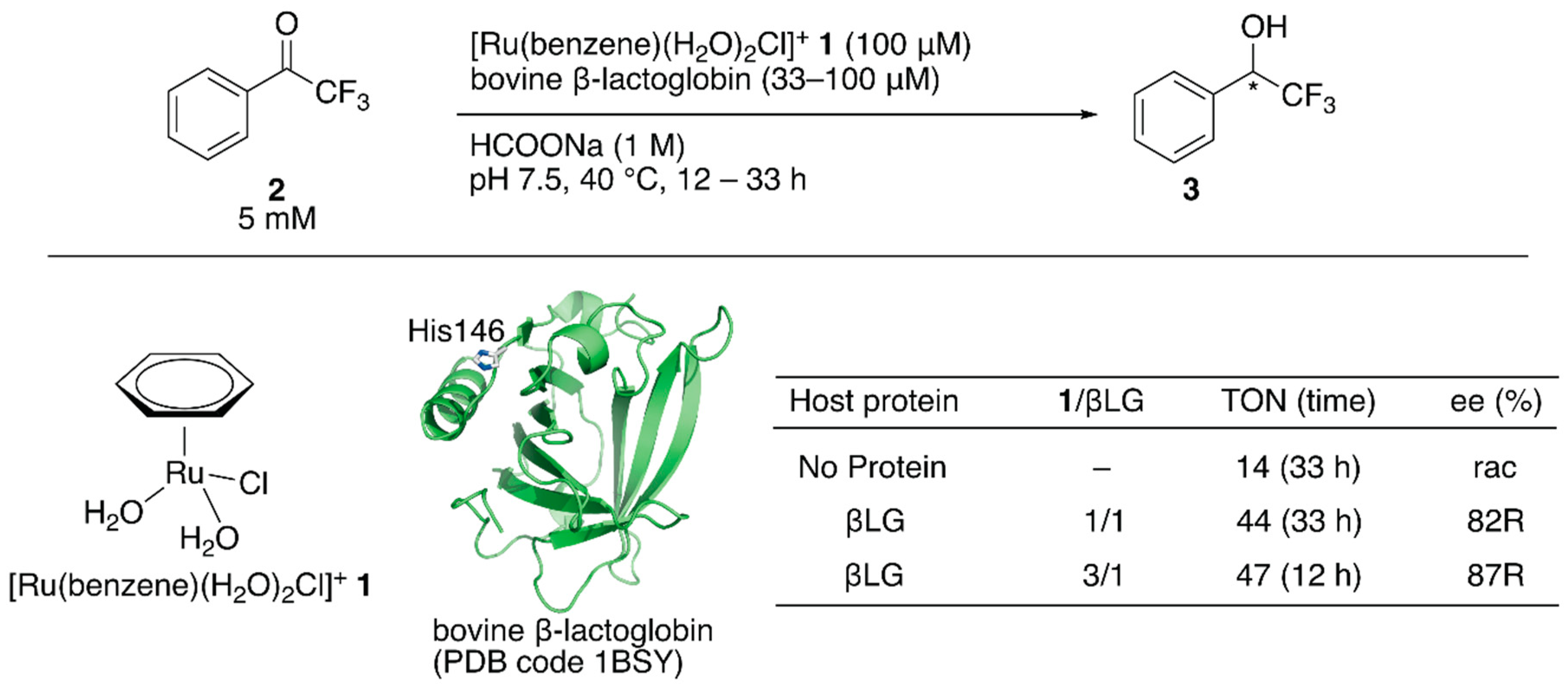
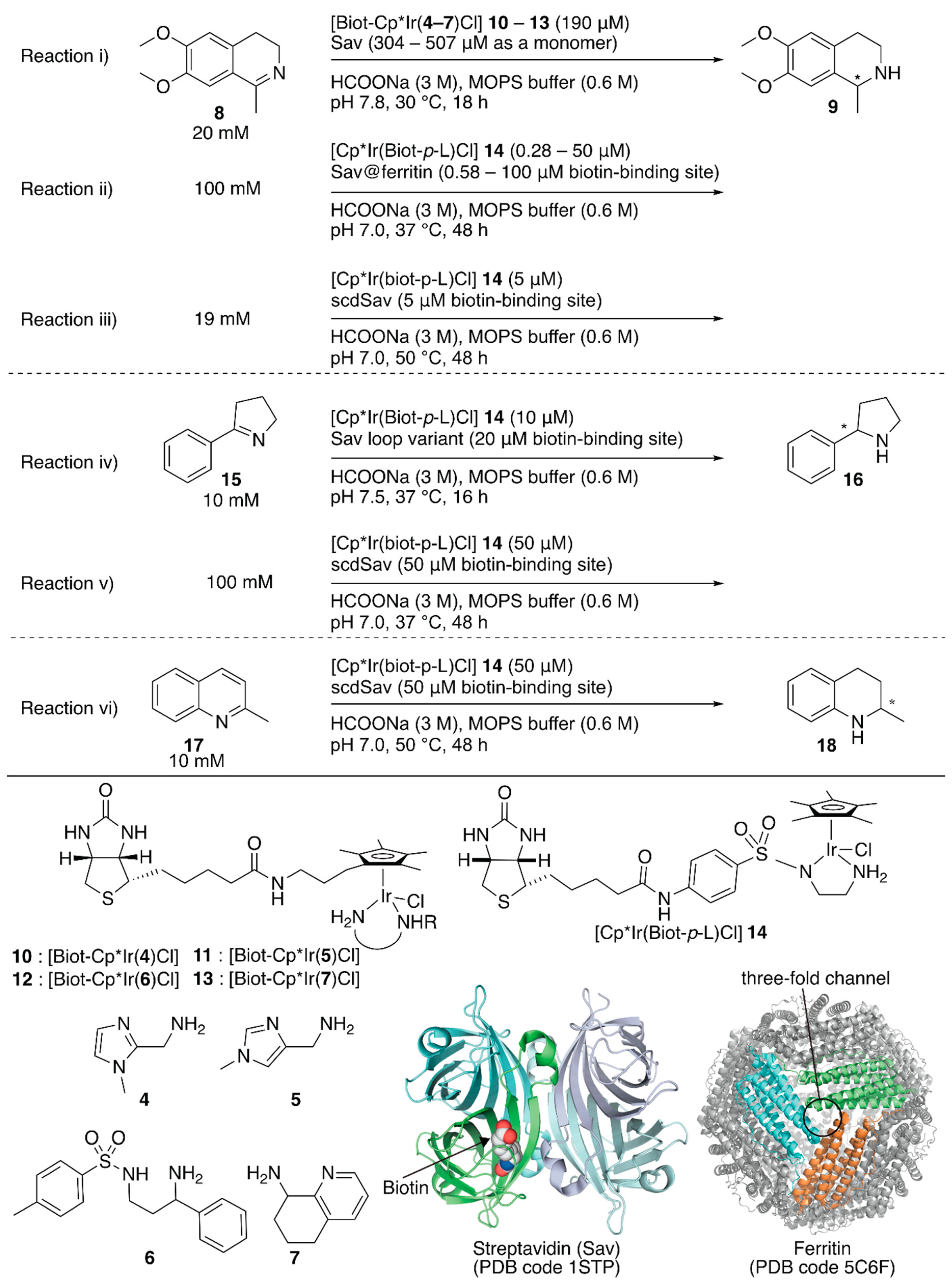
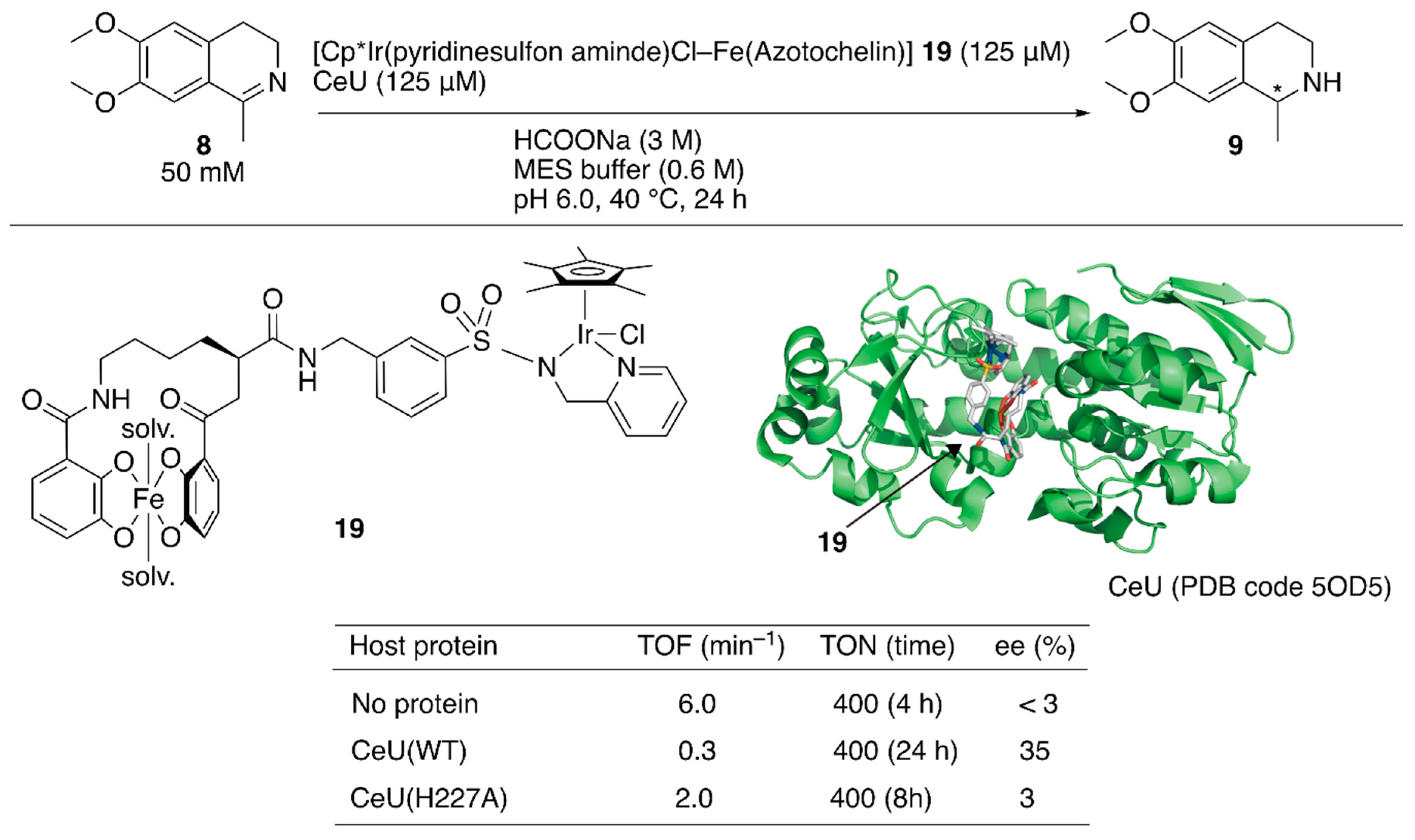

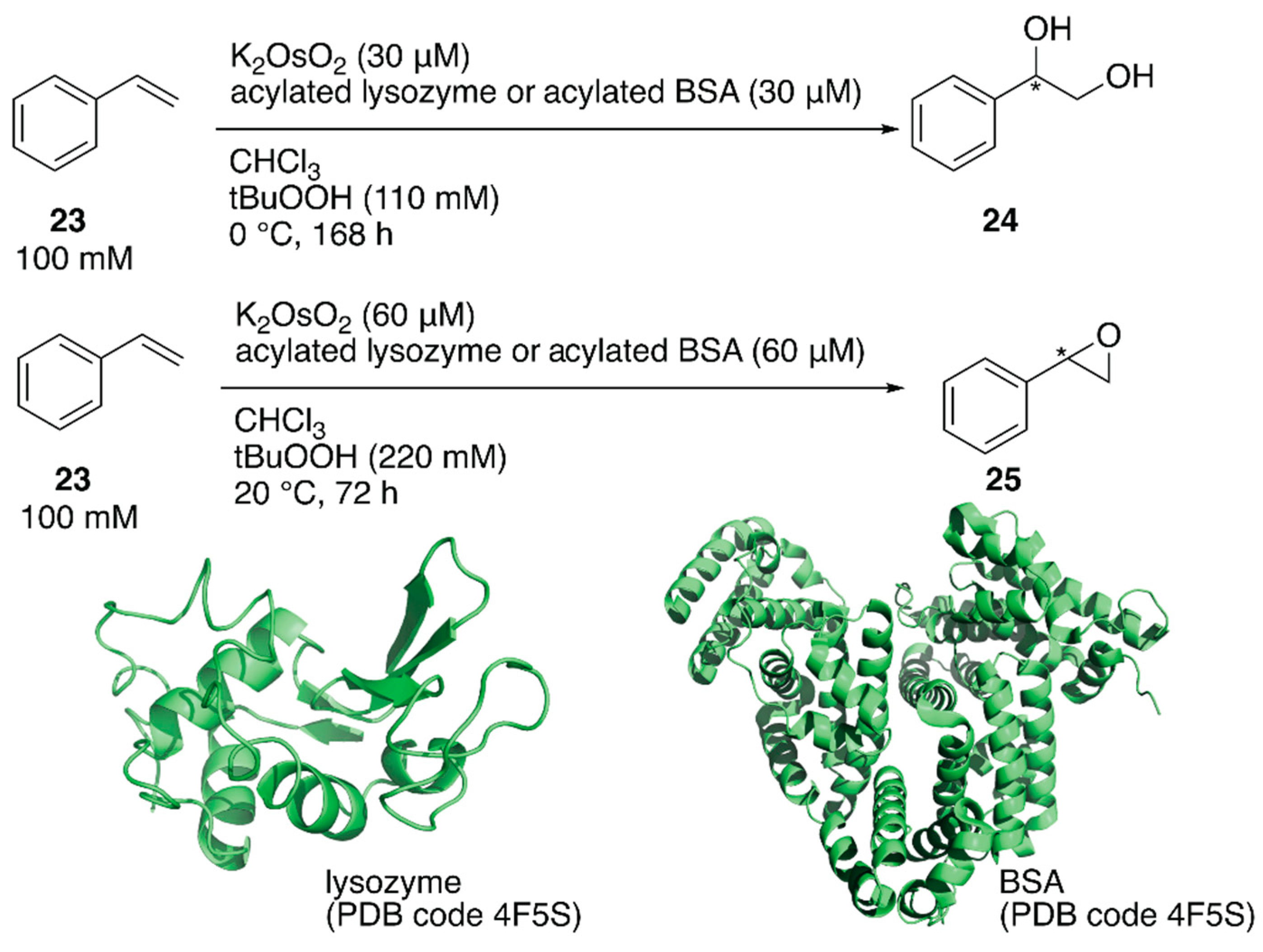

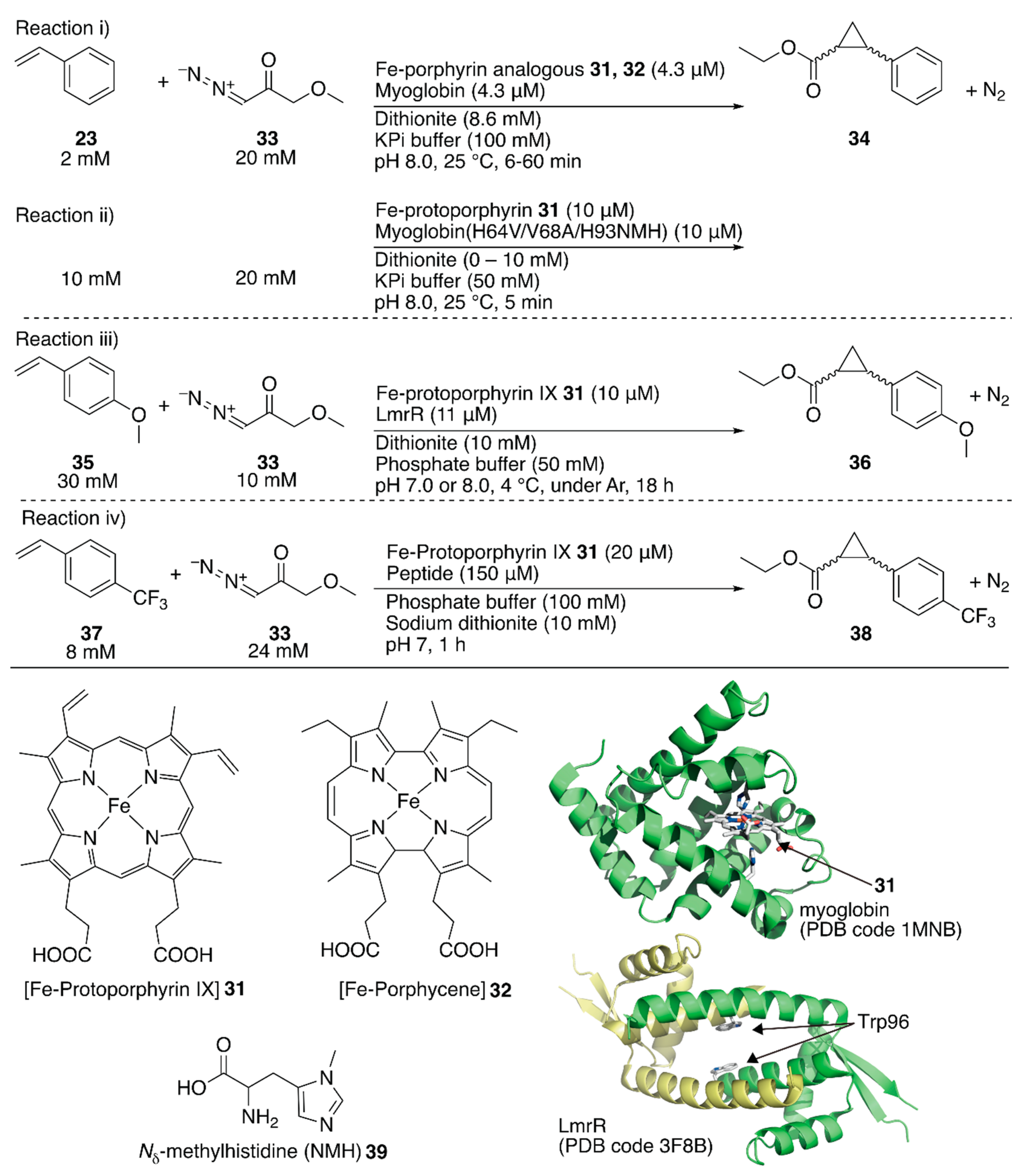
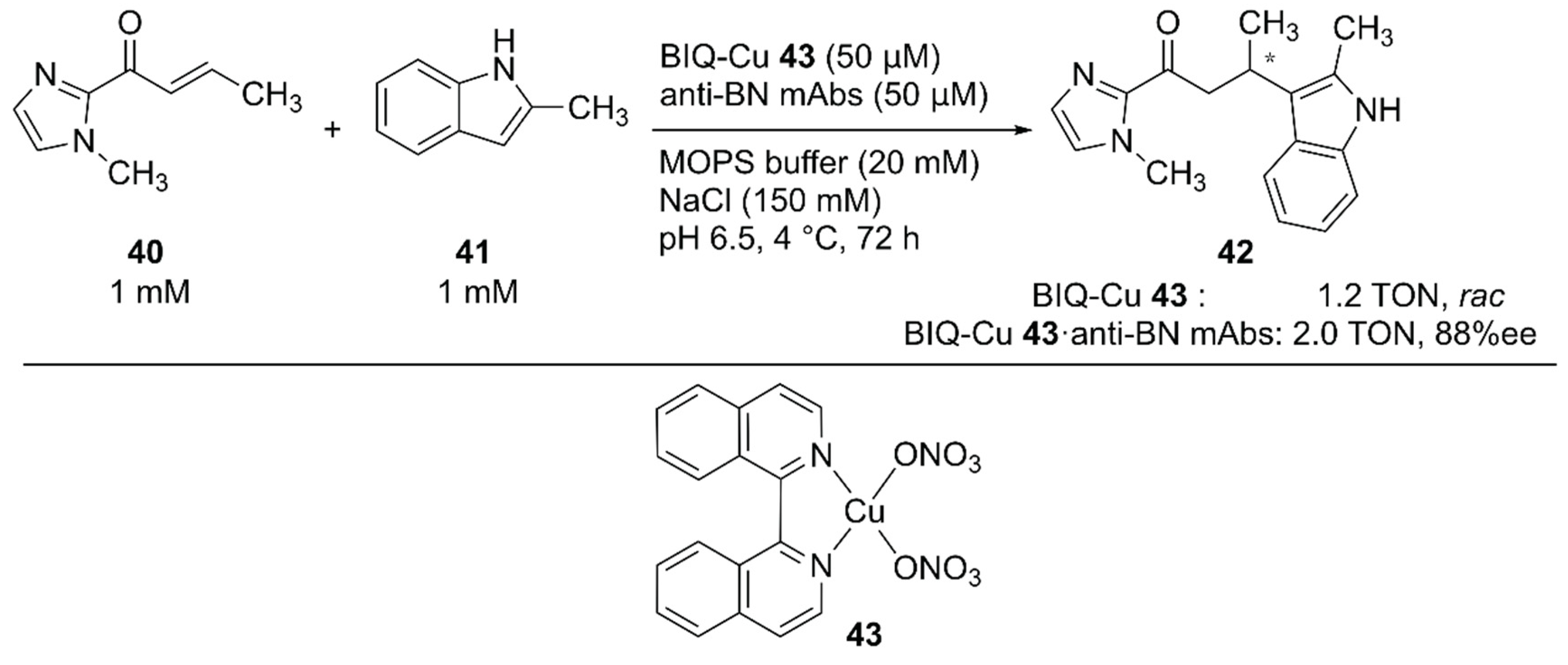

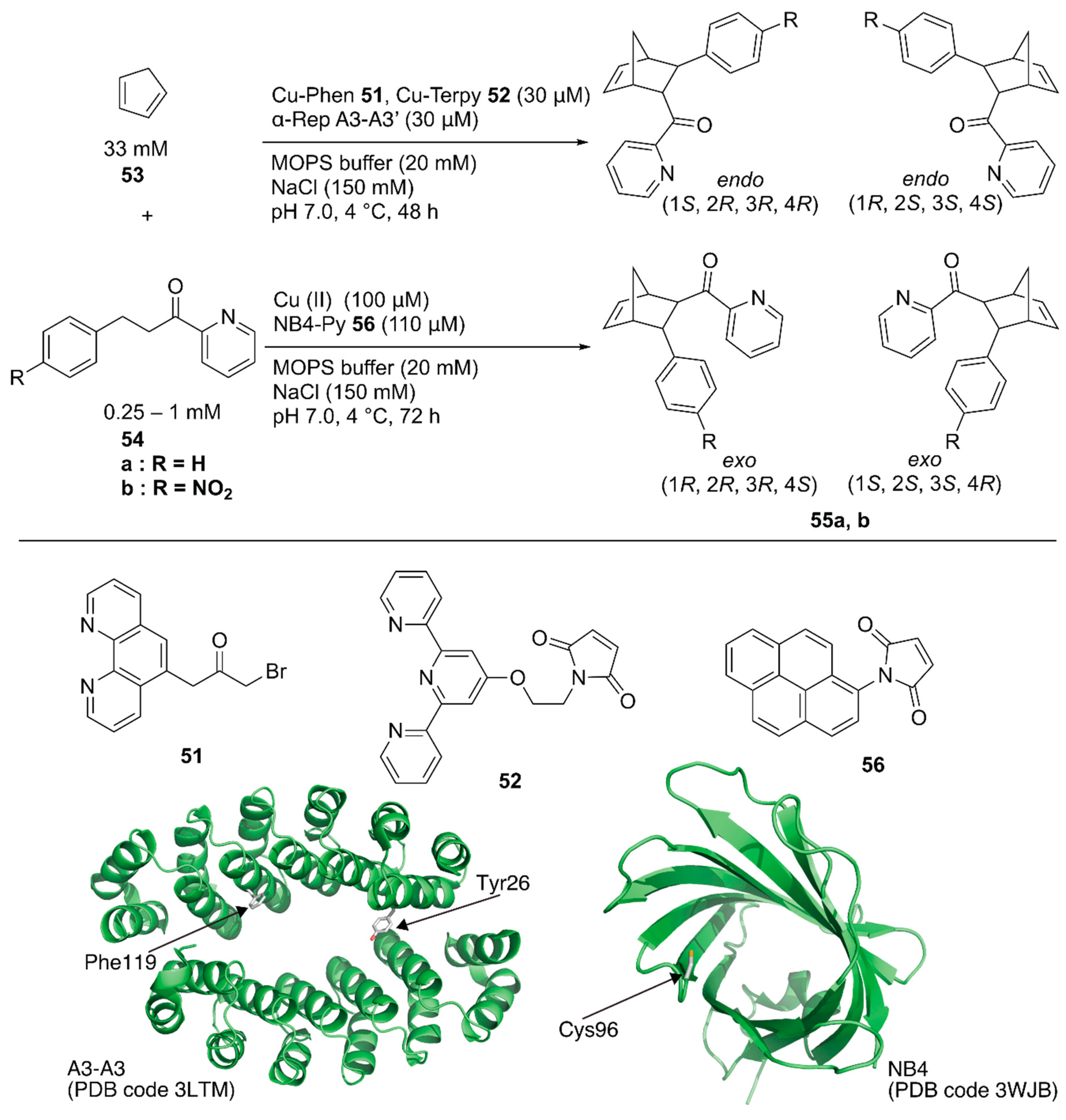

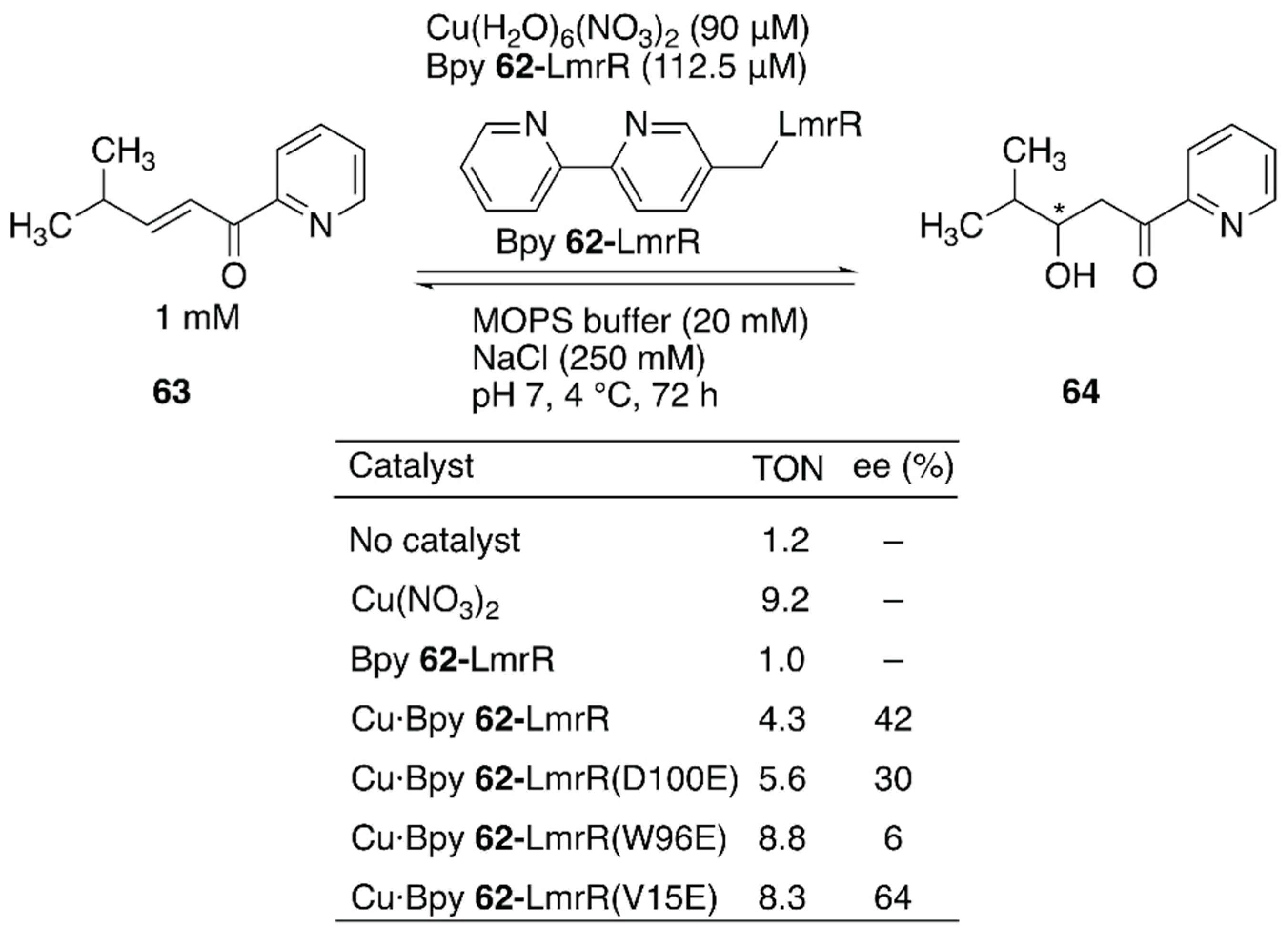
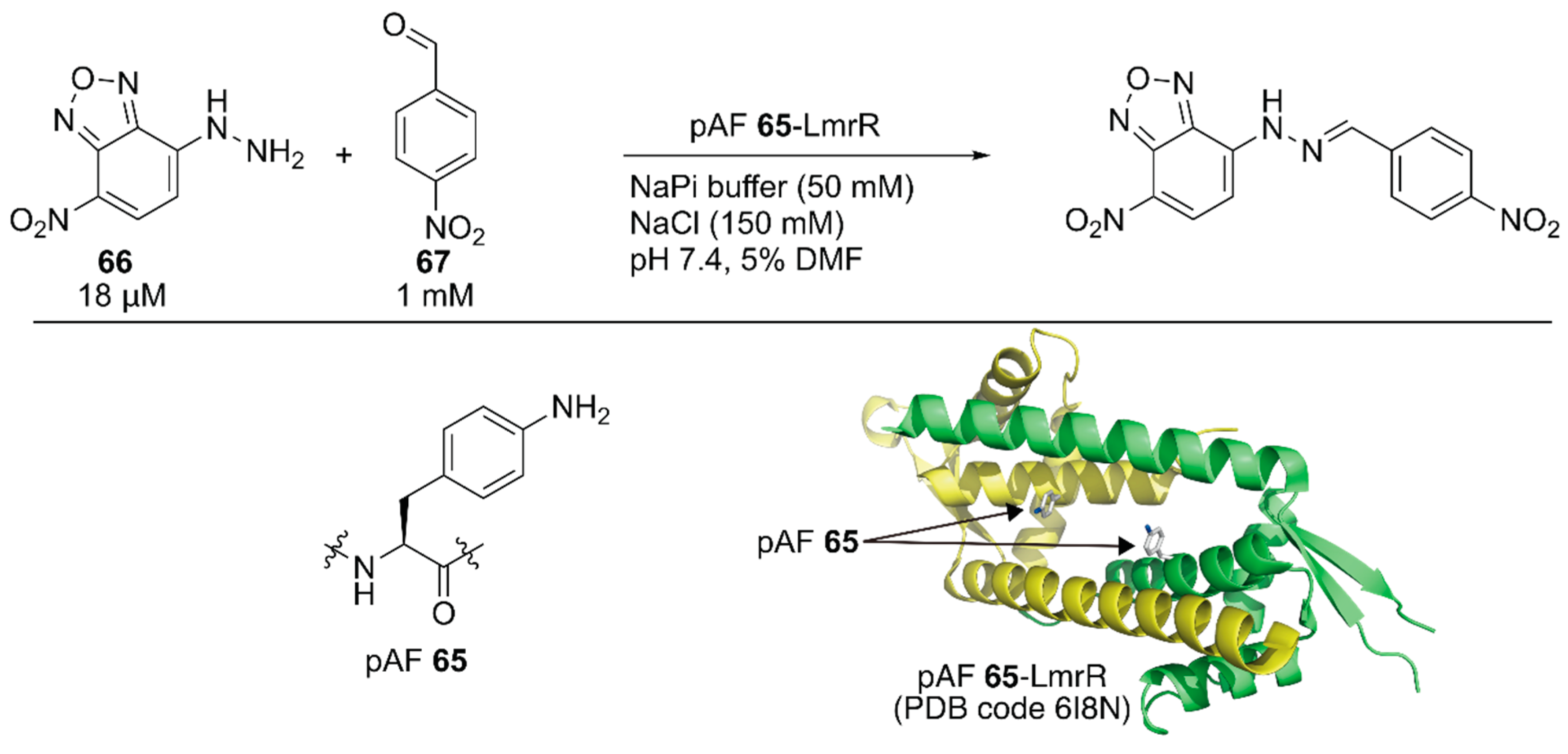

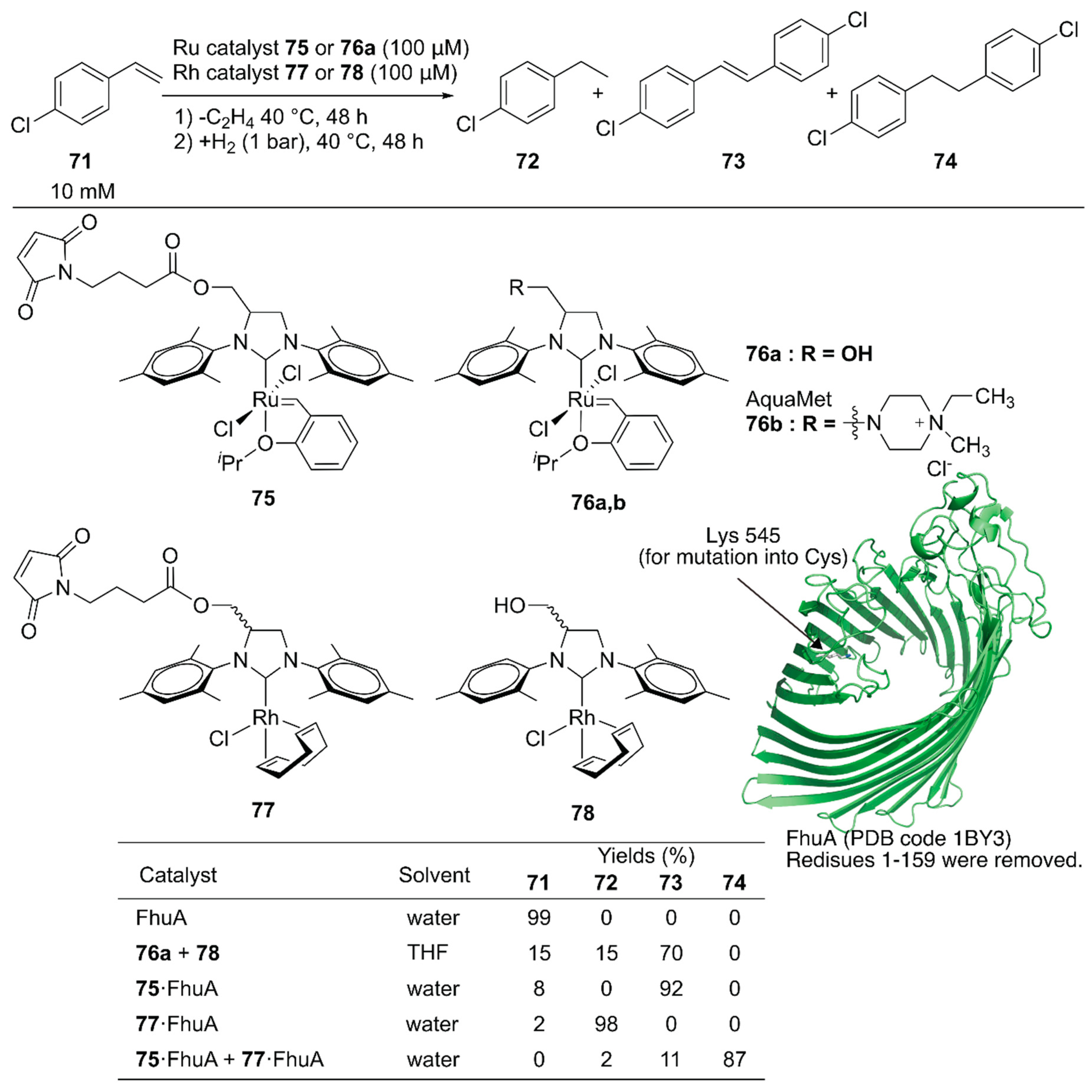
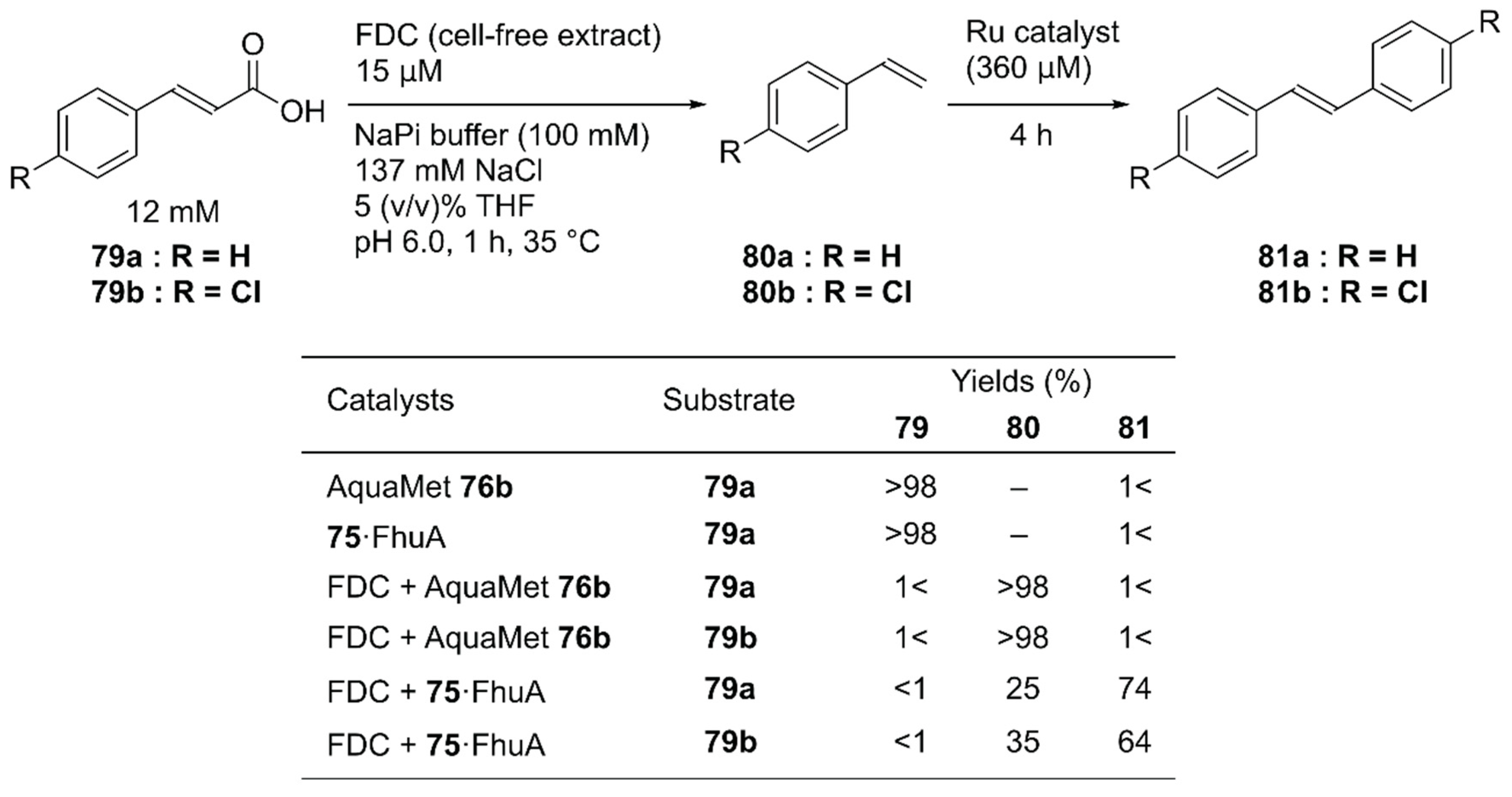

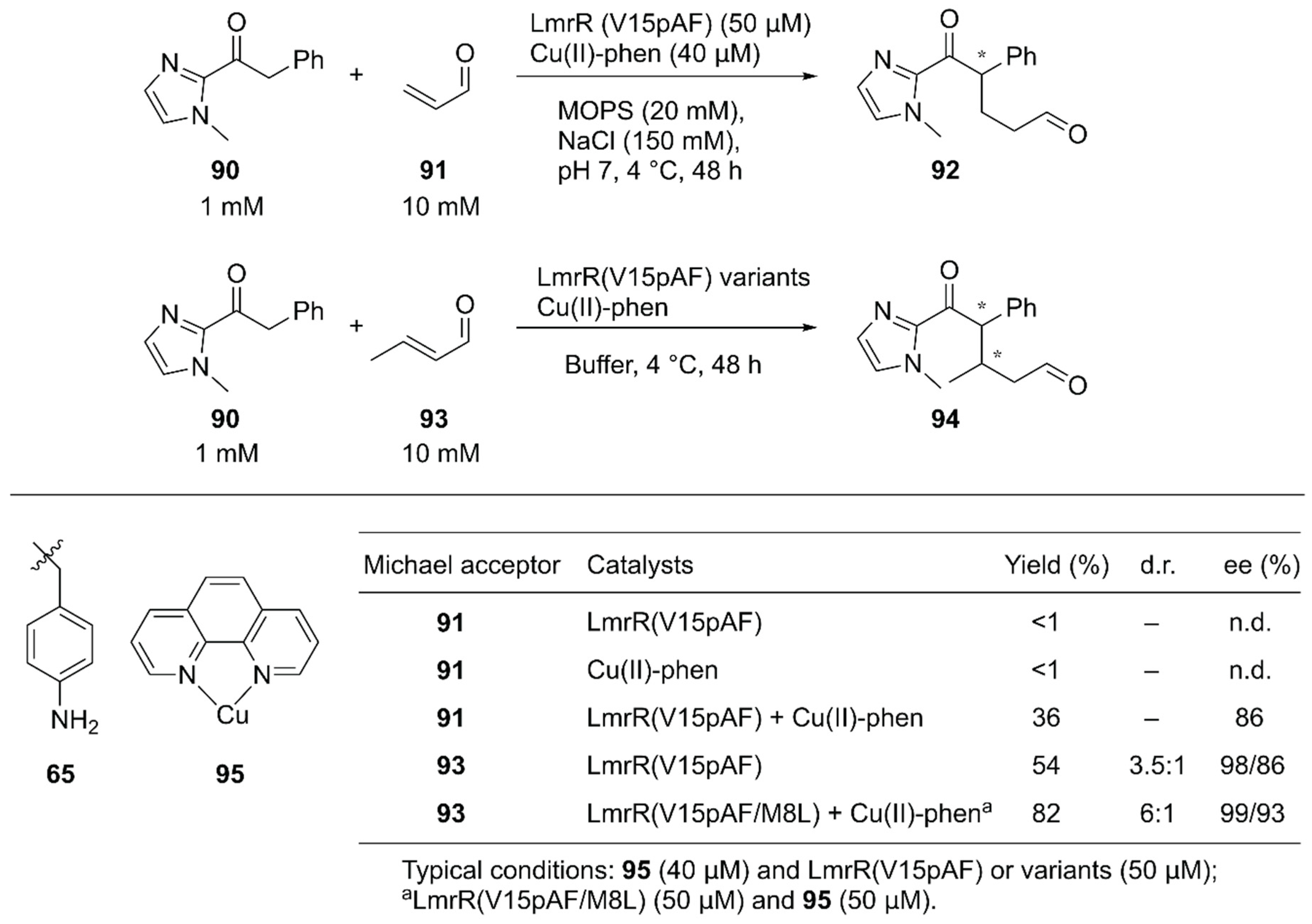
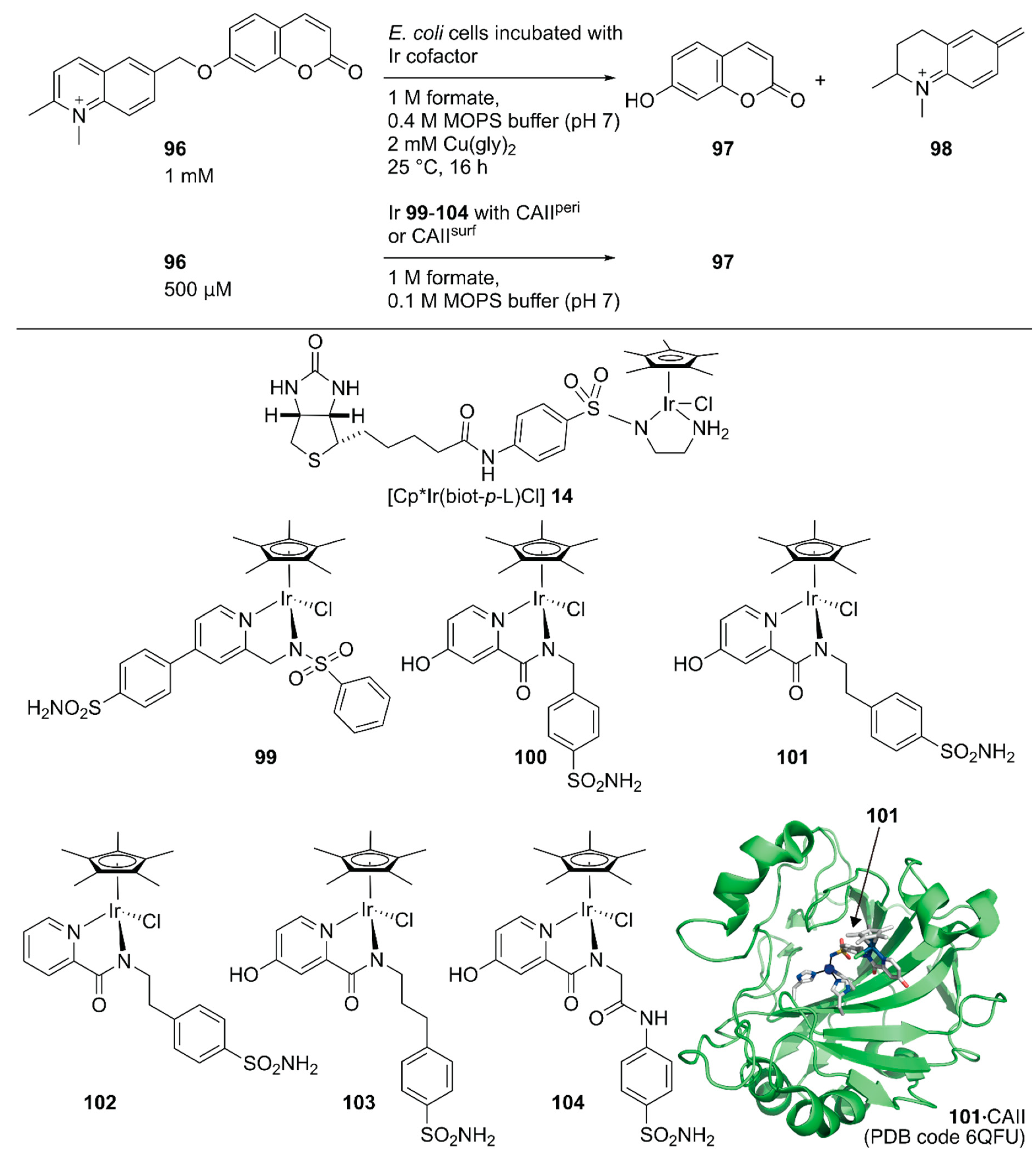
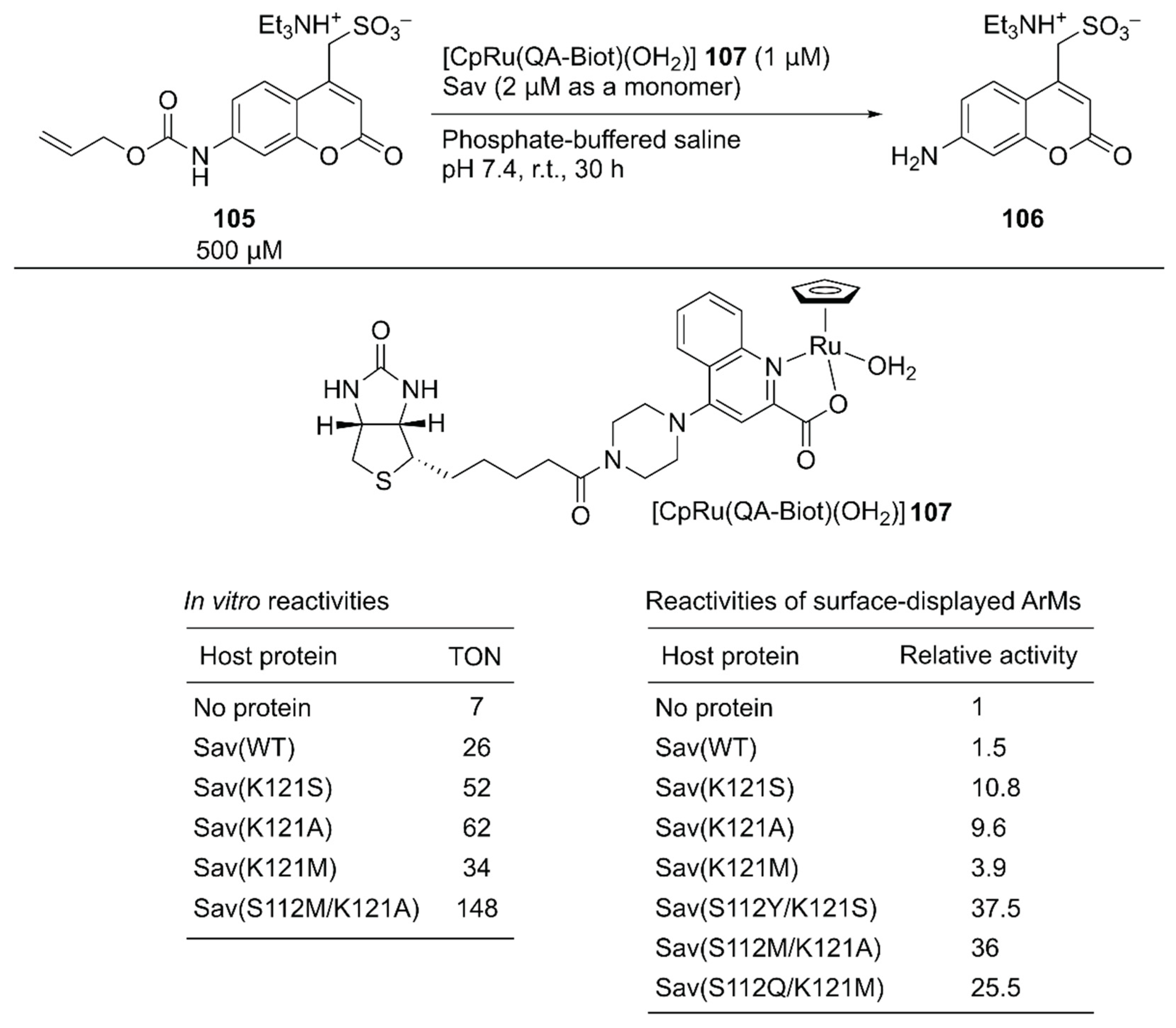
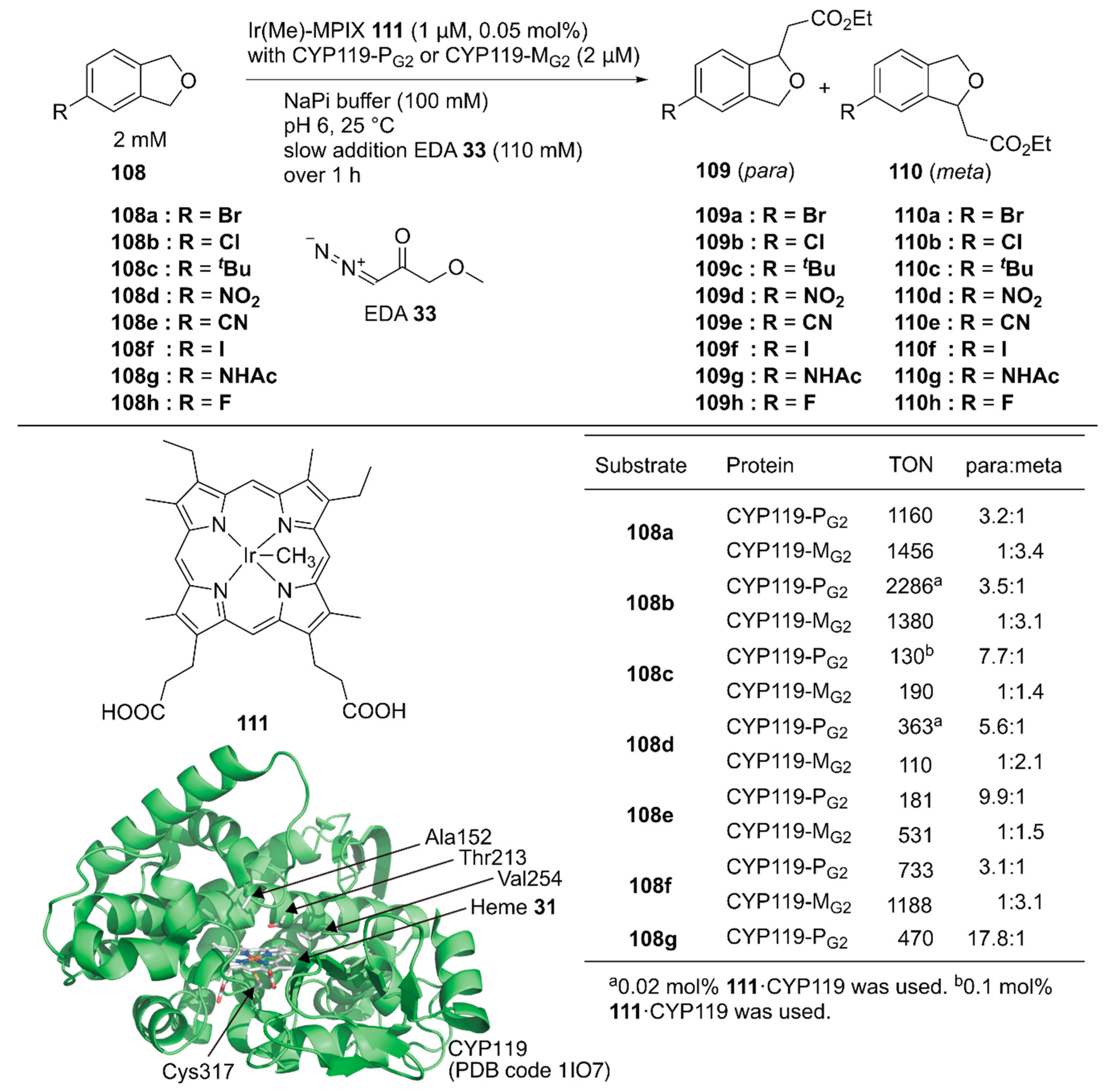

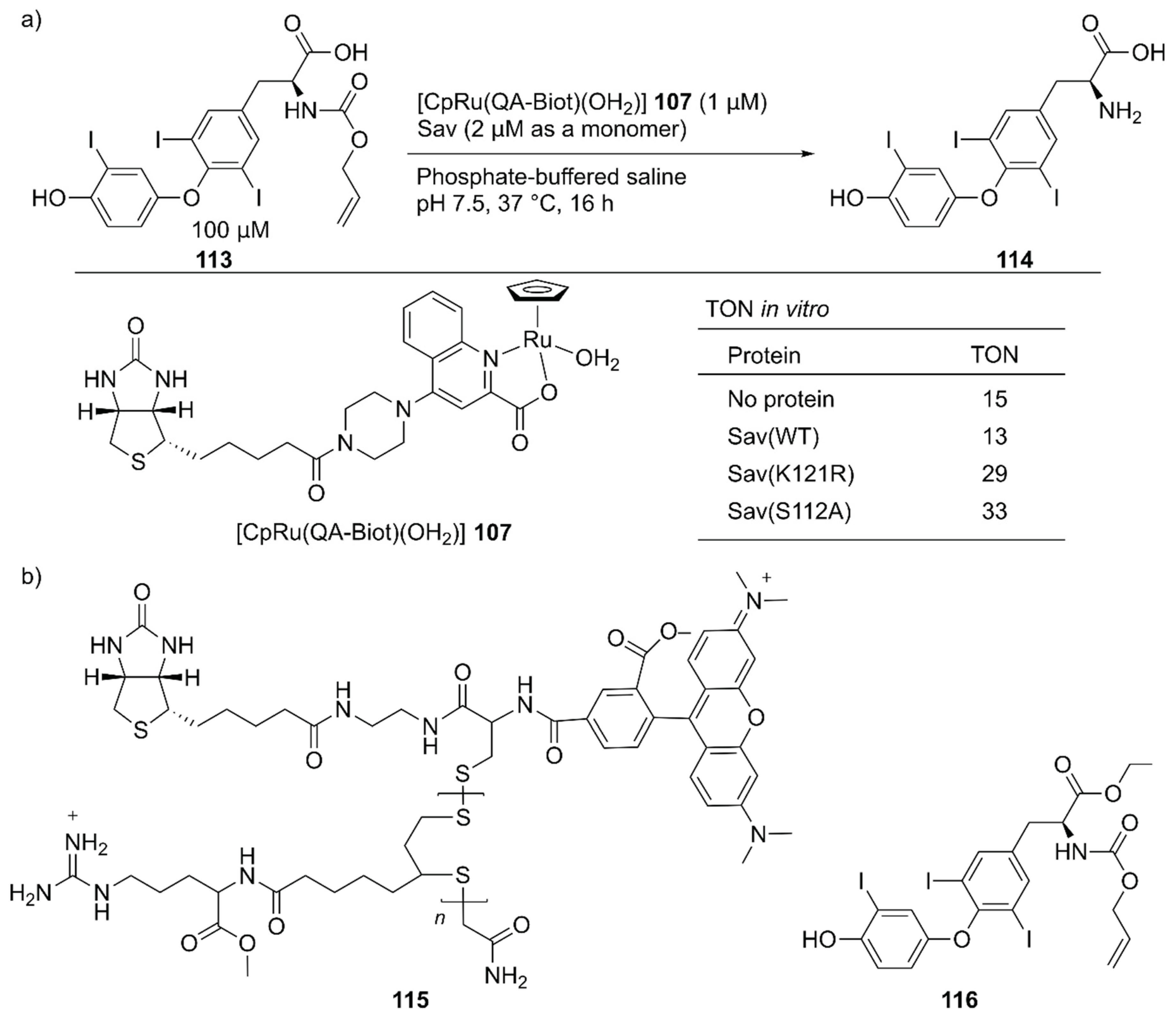
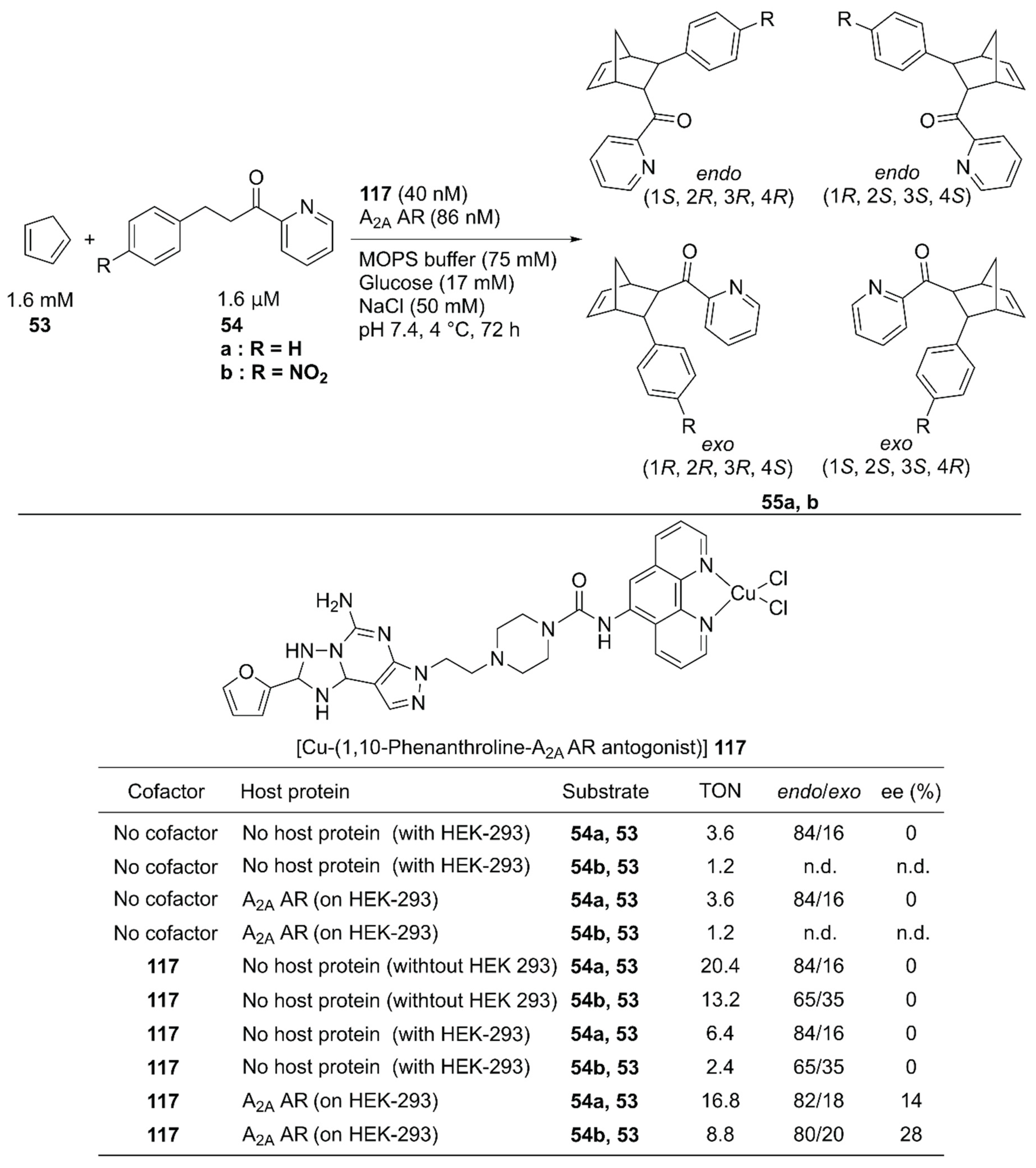
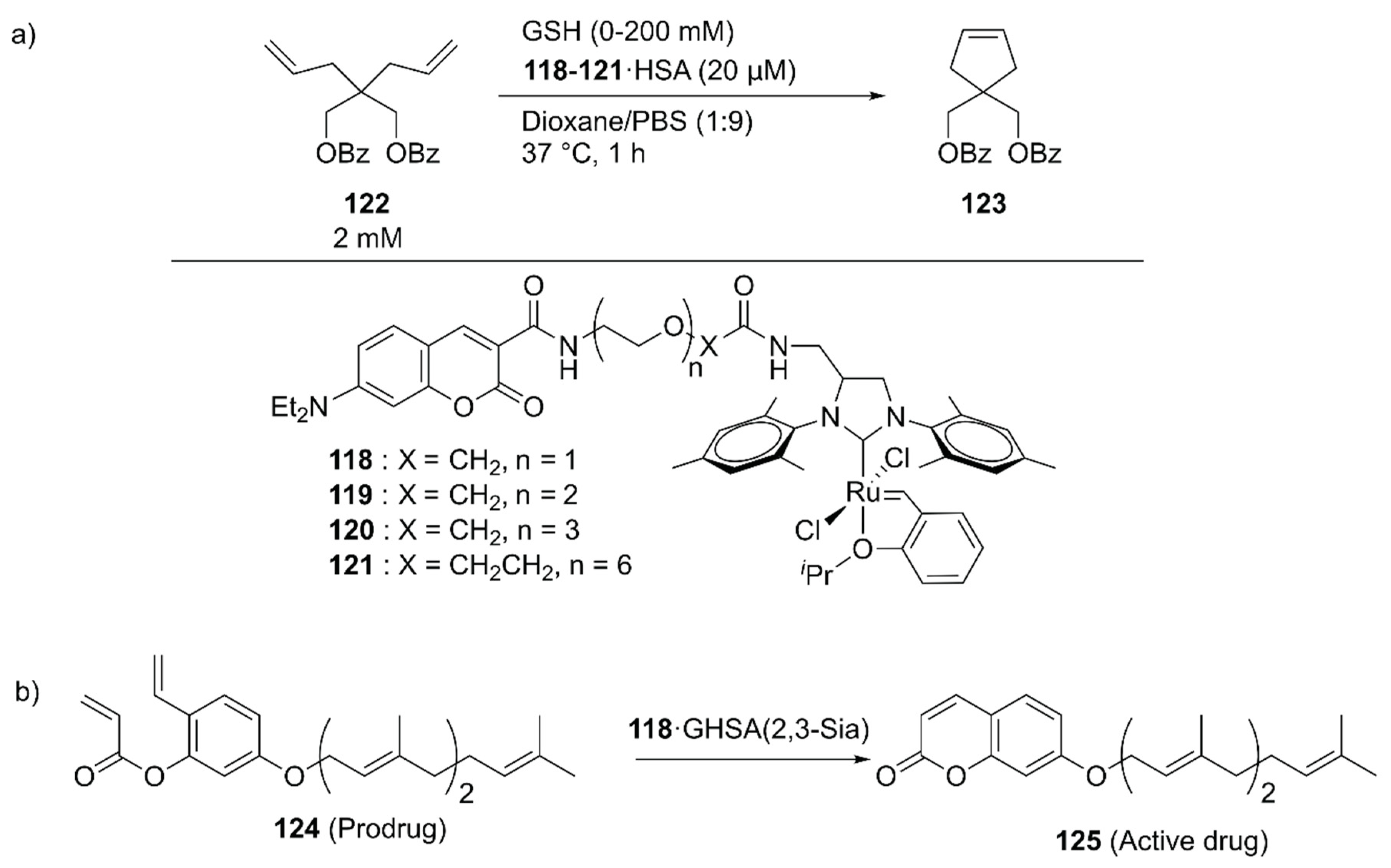
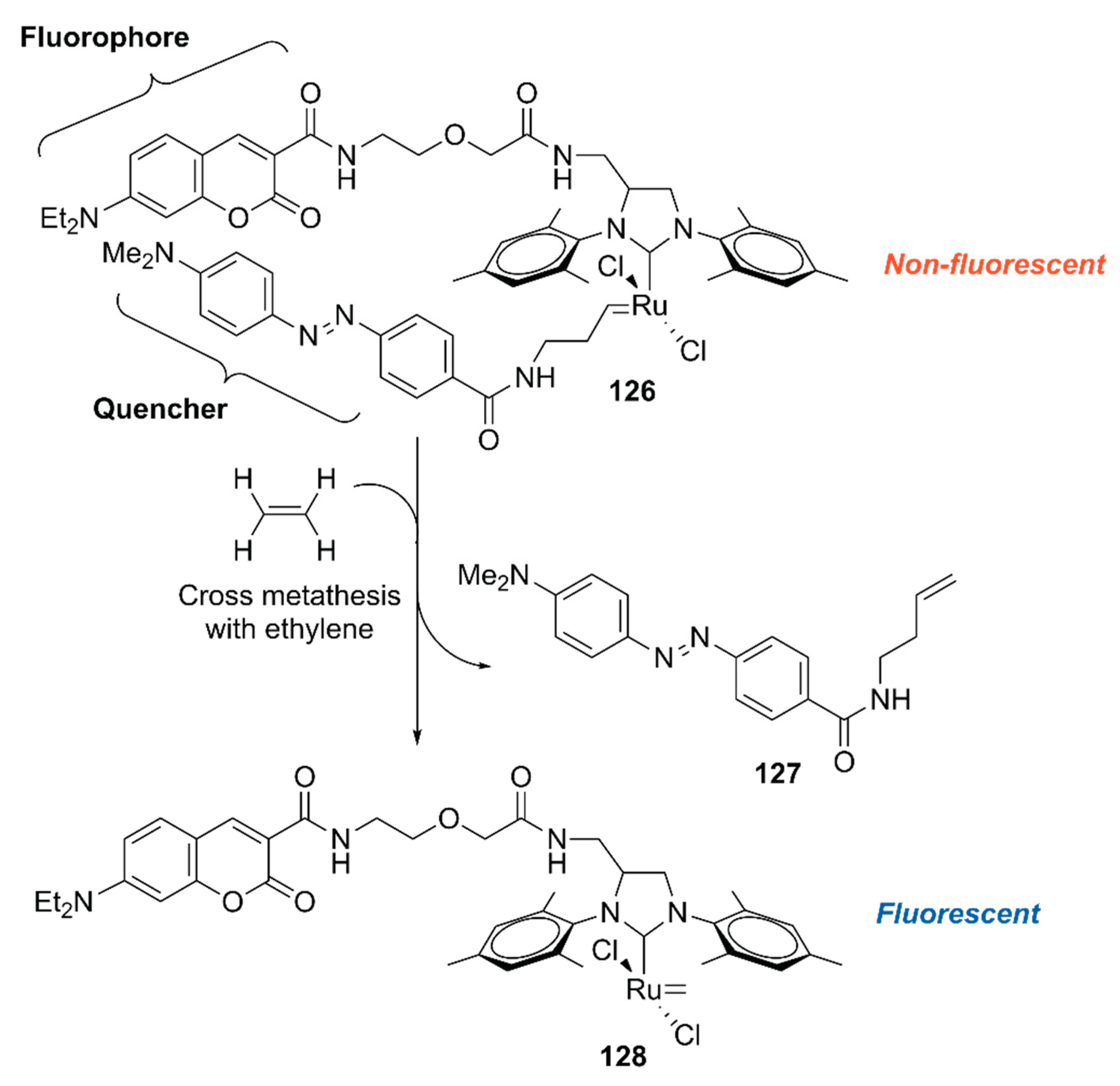
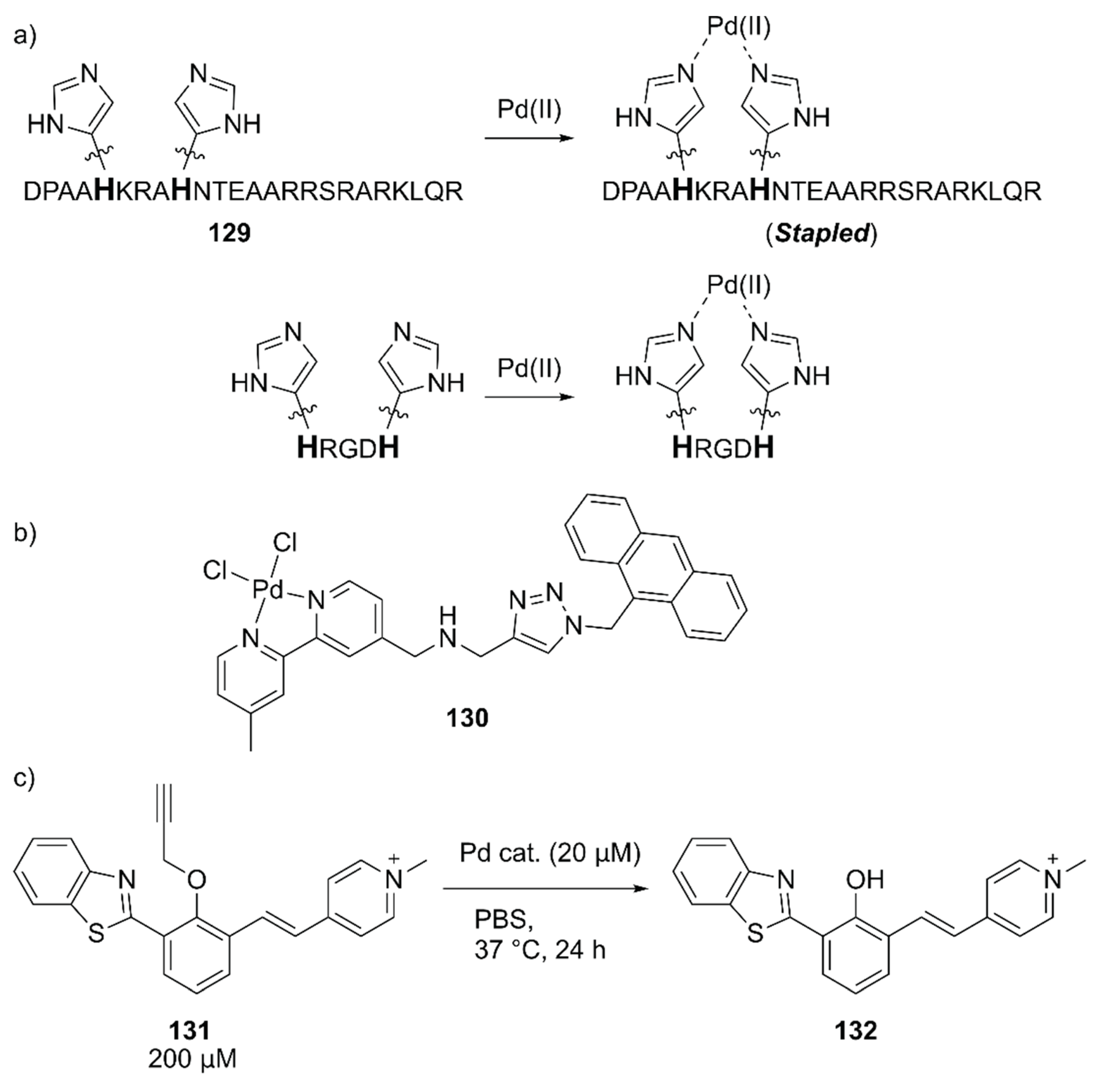
| Entry | Cofactor (cof) | µM | Protein | Substrate | pH | T (°C) | Time (h) | ee % | TON | Ref |
|---|---|---|---|---|---|---|---|---|---|---|
| 1 | (S)-12 | 190 | No protein | 8 | 7.8 | 30 | 18 | 3R | 101 | [35] |
| 2 | (S)-12 | 190 | Sav (WT) | 8 | 7.8 | 30 | 18 | 7R | 43 | [35] |
| 3 | (S)-12 | 190 | Sav(K121A) | 8 | 7.8 | 30 | 18 | 13R | 43 | [35] |
| 4 | (R)-13 | 190 | No protein | 8 | 7.8 | 30 | 18 | 65R | 110 | [35] |
| 5 | (R)-13 | 190 | Sav (WT) | 8 | 7.8 | 30 | 18 | 43R | 13 | [35] |
| 6 | (R)-13 | 190 | Sav (S112M) (cof:Sav = 1.5:4.0) | 8 | 7.8 | 30 | 18 | 68R | 30 | [35] |
| 7 | (R)-13 | 190 | Sav (S112M) (cof:Sav = 2.5:4.0) | 8 | 7.8 | 30 | 18 | 83R | 33 | [35] |
| 8 | 14 | 50 | No protein | 8 | 7.0 | 37 | 48 | rac | 65 | [36] |
| 9 | 14 | 50 | Sav (S112A) | 8 | 7.0 | 37 | 48 | 75R | 142 | [36] |
| 10 | 14 | 50 | Sav (S112K) | 8 | 7.0 | 37 | 48 | 41S | 100 | [36] |
| 11 | 14 | 50 | Sav (S112A/K121A) | 8 | 7.0 | 37 | 48 | 59R | 358 | [36] |
| 12 | 14 | 0.42 | Sav (S112A) @ Ferritin | 8 | 7.0 | 37 | 48 | 46S | 74 | [36] |
| 13 | 14 | 0.40 | Sav (S112K) @ Ferritin | 8 | 7.0 | 37 | 48 | 47S | 46 | [36] |
| 14 | 14 | 0.28 | Sav (S112A/K121A) @ Ferritin | 8 | 7.0 | 37 | 48 | 44S | 117 | [36] |
| 15 | 14 | 10 | No protein | 15 | 7.5 | 37 | 16 | n.d. | 0 | [37] |
| 16 | 14 | 10 | Sav | 15 | 7.5 | 37 | 16 | 76R | 22 | [37] |
| 17 | 14 | 10 | Sav_HP46-52 Inserted seq: LSDEDFKAVFGMTRSAFANLPLWKQQHLKKEKGLF | 15 | 7.5 | 37 | 16 | 80R | 162 | [37] |
| 18 | 14 | 10 | Sav_FPD46-52 Inserted seq: SPLSEALTKANSPAEAYKASRGAG | 15 | 7.5 | 37 | 16 | 82R | 158 | [37] |
| 19 | 14 | 25 | No protein | 8 | 7.0 | 25 | 24 | rac | 72 | [38] |
| 20 | 14 | 25 | Sav | 8 | 7.0 | 25 | 24 | 30R | 88 | [38] |
| 21 | 14 | 25 | scdSav (112SA/121KA/112SB/121KB) | 8 | 7.0 | 25 | 24 | 73R | 176 | [38] |
| 22 | 14 | 25 | scdSav (112SA/121AA/112RB/121KB) | 8 | 7.0 | 25 | 24 | 96R | 400 | [38] |
| 23 | 14 | 5 | monovalent scdSav (112SA/121AA/112RB/121KB) | 8 | 7.0 | 50 | 48 | 90R | 17700 | [38] |
| 24 | 14 | 50 | scdSav (112SA/121KA/112AB/121AB) | 15 | 7.0 | 37 | 48 | 96R | 1976 | [38] |
| 25 | 14 | 50 | monovalent scdSav (112SA/121AA/112RB/121KB) | 17 | 7.0 | 50 | 48 | 91R | 195 | [38] |
| Entry | Metal Source | Host Protein | Modification | [Metal] (µM) | Substrate | Product | tBuOOH (mM) | T (°C) | Time (h) | TON | ee% |
|---|---|---|---|---|---|---|---|---|---|---|---|
| 1 | K2OsO2 | Lysozyme | HA | 30 | 23 | 24 | 110 | 0 | 168 | 289 | 98S |
| 2 | K2OsO2 | Lysozyme | PA | 30 | 23 | 24 | 110 | 0 | 168 | 85 | 94S |
| 3 | K2OsO2 | Lysozyme | AA | 30 | 23 | 24 | 110 | 0 | 168 | 103 | 55S |
| 4 | K2OsO2 | BSA | AA | 30 | 23 | 24 | 110 | 0 | 168 | 275 | 73S |
| 5 | RuCl3 | Lysozyme | No modification | 60 | 23 | 25 | 220 | 20 | 72 | 361 | 10R |
| 6 | RuCl3 | Lysozyme | HA | 60 | 23 | 25 | 220 | 20 | 72 | 449 | 56R |
| 7 | RuCl3 | Lysozyme | PA | 60 | 23 | 25 | 220 | 20 | 72 | 561 | 74R |
| 8 | RuCl3 | Lysozyme | AA | 60 | 23 | 25 | 220 | 20 | 72 | 749 | 63R |
| 9 | RuCl3 | BSA | HA | 60 | 23 | 25 | 220 | 20 | 72 | 452 | 88R |
| 10 | RuCl3 | BSA | HA | 180 | 23 | 25 | 220 | 40 | 72 | 2613 | 82R |
| Entry | Cof | Host Protein | [Cof] (µM) | Substrate | pH | T (°C) | Time (h) | TON | de for (E) | ee% (1R,2R) | Ref |
|---|---|---|---|---|---|---|---|---|---|---|---|
| 1 | 31 | No protein | 4.3 | 23, 33 | 8.0 | 25 | 60 | 23 | 62 | n.d. | [55] |
| 2 | 31 | Mb | 4.3 | 23, 33 | 8.0 | 25 | 60 | 49 | 85 | n.d. | [55] |
| 3 | 32 | No protein | 4.3 | 23, 33 | 8.0 | 25 | 6 | 9 | 53 | n.d. | [55] |
| 4 | 32 | Mb | 4.3 | 23, 33 | 8.0 | 25 | 6 | 133 | > 99 | n.d. | [55] |
| 5 | 31 | No protein | 10 | 33, 35 | 8.0 | 4 | 18 | 51 | >70 | – | [59] |
| 6 | 31 | LmrR | 10 | 33, 35 | 8.0 | 4 | 18 | 247 | >70 | 17 | [59] |
| 7 | 31 | LmrR (F93A) | 10 | 33, 35 | 8.0 | 4 | 18 | 232 | >70 | 11 | [59] |
| 8 | 31 | LmrR (D110A) | 10 | 33, 35 | 8.0 | 4 | 18 | 375 | >70 | 24 | [59] |
| 9 | 31 | LmrR (W96A) | 10 | 33, 35 | 8.0 | 4 | 18 | 276 | >70 | <5 | [59] |
| 10 | 31 | LmrR (V15A) | 10 | 33, 35 | 8.0 | 4 | 18 | 15 | >70 | 17 | [59] |
| 11 | 31 | LmrR (M8A) | 10 | 33, 35 | 8.0 | 4 | 18 | 359 | >70 | 44 | [59] |
| 12 | 31 | LmrR (M8A) | 10 | 33, 35 | 7.0 | 4 | 18 | 449 | >70 | 51 | [59] |
| 13 | 31 | No peptide | 20 | 33, 37 | 7.0 | – | 1 | 60 | 70 | 0 | [62] |
| 14 | 31 | LILHLFL | 20 | 33, 37 | 7.0 | – | 1 | 208 | 68 | –40 | [62] |
| 15 | 31 | LHLH (l-NMe) FL | 20 | 33, 37 | 7.0 | – | 1 | 64 | 80 | 0 | [62] |
| 16 | 31 | (d)-LILHLFL | 20 | 33, 37 | 7.0 | – | 1 | 200 | – | 40 | [62] |
| Entry | Cof | Protein | [Cof] (µM) | [53] (mM) | [54a] (mM) | Yield (%) | Time (h) | TON | endo/exo | ee (%) for 1S,2R,3R,4R | Ref |
|---|---|---|---|---|---|---|---|---|---|---|---|
| 1 | Cu-Phen 51 | A3-A3′(Y26C) | 30 | 34 | 1 | 21 | 48 | 7.0 | n.d. | 22 | [79] |
| 2 | Cu-Terpy 52 | A3-A3′(Y26C) | 30 | 34 | 1 | 16 | 48 | 5.3 | n.d. | 14 | [79] |
| 3 | Cu-Phen 51 | A3-A3′(F119C) | 30 | 34 | 1 | 38 | 48 | 12.7 | 92/8 | 5 | [79] |
| 4 | Cu-Terpy 52 | A3-A3′(F119C) | 30 | 34 | 1 | 15 | 48 | 5.0 | 93/7 | 52 | [79] |
| 5 | Cu2+ ion | No protein | 100 | 33 | 1 | 82 | 72 | 8.2 | 92:8 | < 5 | [83] |
| 6 | Cu2+ ion | NB4 | 100 | 33 | 1 | 16 | 72 | 1.6 | 89:11 | –6 | [83] |
| 7 | Cu2+ ion | NB4-Pyr 56 | 100 | 33 | 1 | 56 | 72 | 5.6 | 95:5 | 69 | [83] |
| 8 | Cu2+ ion | NB4-Pyr 56 | 100 | 33 | 0.25 | 94 | 72 | 2.4 | 96:4 | 78 | [83] |
© 2020 by the authors. Licensee MDPI, Basel, Switzerland. This article is an open access article distributed under the terms and conditions of the Creative Commons Attribution (CC BY) license (http://creativecommons.org/licenses/by/4.0/).
Share and Cite
Himiyama, T.; Okamoto, Y. Artificial Metalloenzymes: From Selective Chemical Transformations to Biochemical Applications. Molecules 2020, 25, 2989. https://doi.org/10.3390/molecules25132989
Himiyama T, Okamoto Y. Artificial Metalloenzymes: From Selective Chemical Transformations to Biochemical Applications. Molecules. 2020; 25(13):2989. https://doi.org/10.3390/molecules25132989
Chicago/Turabian StyleHimiyama, Tomoki, and Yasunori Okamoto. 2020. "Artificial Metalloenzymes: From Selective Chemical Transformations to Biochemical Applications" Molecules 25, no. 13: 2989. https://doi.org/10.3390/molecules25132989
APA StyleHimiyama, T., & Okamoto, Y. (2020). Artificial Metalloenzymes: From Selective Chemical Transformations to Biochemical Applications. Molecules, 25(13), 2989. https://doi.org/10.3390/molecules25132989






